#best places to travel in february europe
Text
10 Best Places to Travel in February
10 Best Places to Travel in February
Are you planning Valentine’s Day getaway for two or a group trip for Presidents’ Day weekend?
We determined where to travel during the shortest month of the year by considering sights, weather, traveler sentiment, and annual events.
These are the best places to visit in February, ranging from mountain towns to beach getaways. Do you want to weigh in? Vote in the poll below to help us create the…
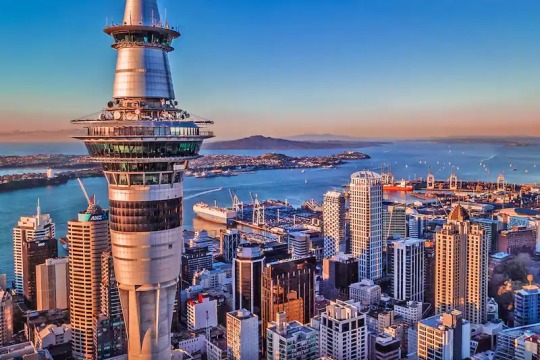
View On WordPress
#best beach vacations in february 2022#best islands to visit in february#best places to travel in february 2021#best places to travel in february 2022#best places to travel in february europe#best places to travel in february for couples#best places to travel in february in usa#warm places to travel in february 2022
0 notes
Text
#best places to travel#best places to travel in february#best places to travel in the us#best places to vacation in the us#best places to visit in california#best places to visit in december#best places to visit in europe#best places to visit in italy#best places to visit in mexico#best places to visit in spain#best places to visit in the world#best solo female travel destinations#best solo travel destinations#best solo travel destinations usa#Best Travel Destination Amsterdam#Best Travel Destination Aotearoa#best travel destination august#Best Travel Destination Australia#Best Travel Destination Bangkok#Best Travel Destination Beijing#Best Travel Destination Berlin#Best Travel Destination Budapest#Best Travel Destination Cartagena#best travel destination countries#Best Travel Destination Doha#Best Travel Destination Dubai#Best Travel Destination Ecuador#best travel destination for christmas#best travel destination for families#best travel destination for singles
0 notes
Text
THIS DAY IN GAY HISTORY
based on: The White Crane Institute's 'Gay Wisdom', Gay Birthdays, Gay For Today, Famous GLBT, glbt-Gay Encylopedia, Today in Gay History, Wikipedia, and more … February 13



518 B.C. – Pindar, the Greek poet was born today. Again, it is impossible to say precisely when the Theban poet was born, so we're picked this arbitrary date. So this is as good a place as any to mention Pindar, the greatest lyric poet of ancient Greece, whose love for Theoxenus of Tenedos is celebrated in his verse.


Self-portrait
1891 – Grant Wood (d.1942) was an American painter born four miles east of Anamosa, Iowa. He is best known for his paintings depicting the rural American Midwest, particularly the painting American Gothic, an iconic image of the 20th century.
After graduating from Washington High School, Wood enrolled in an art school in Minneapolis in 1910, and returned a year later to teach in a one-room schoolhouse. In 1913 he enrolled at the School of the Art Institute of Chicago and performed some work as a silversmith. From 1920 to 1928, he made four trips to Europe, where he studied many styles of painting, especially Impressionism and Post-Impressionism. But it was the work of the 15th-century Flemish artist Jan van Eyck that influenced him to take on the clarity of this new technique and to incorporate it in his new works.
From 1924 to 1935, Wood lived in the loft of a carriage house that he turned into his personal studio at "5 Turner Alley" (the studio had no address until Wood made one up himself). In 1932, Wood helped found the Stone City Art Colony near his hometown to help artists get through the Great Depression. He became a great proponent of regionalism in the arts, lecturing throughout the country on the topic. Wood taught painting at the University of Iowa's School of Art from 1934 to 1941. During that time, he supervised mural painting projects, mentored students, produced a variety of his own works, and became a key part of the University's cultural community.
One common theory is that he was a closeted homosexual, and was fired from the University because of a relationship with his personal secretary.
On February 12, 1942, one day before his 51st birthday, Wood died at the university hospital of pancreatic cancer. When Wood died, his estate went to his sister, Nan Wood Graham, the woman portrayed in American Gothic.

Wood's best known work, his 1930 painting American Gothic, is also one of the most famous paintings in American art, and one of the few images to reach the status of universally recognised cultural icon, comparable to Leonardo da Vinci's Mona Lisa and Edvard Munch's The Scream.
It was first exhibited in 1930 at the Art Institute of Chicago, where it is still located. It was given a $300 prize and made news stories country-wide, bringing Wood immediate recognition. Since then, it has been borrowed and satirised endlessly for advertisements and cartoons.


Wheeler and Wescott by Lynes
1899 – on this date the American curator Monroe Wheeler, was born (d.1988). Poet and author Glenway Wescott and Monroe Wheeler were an extraordinary couple. The two met for the first time in 1919, and it was, it seems, a classic case of love at first sight. At the time, Wescott was still in his teens and Wheeler just 20. Seemingly inured to the social mores of the time and inconstancies of youth, the two embarked on a relationship that can be called nothing short of a marriage, for the next 68 years, until Wescott's death in 1987. They are perfect gay Valentine icons.
The young couple travelled the world, stopping in on Gertrude Stein's Paris Salon and crossing paths with Jean Cocteau on the Riviera, while Wescott developed his poetry and later fiction (he authored The Grandmothers and The Pilgrim Hawk, among other bestsellers of his day) and Wheeler found his path. Eventually he would become the director of exhibitions and publications at the Museum of Modern Art.
The two moved with equal ease through the literary and artistic circles of London and the continent as well as their families' Midwestern homes. That their relationship thrived is notable enough. But 1927 brought a new challenge to their pairing. High-school student George Platt Lynes fell passionately in love with the strikingly good-looking Wheeler. And Wheeler, for his part, was entranced by Lyne's 'full, luscious mouth and his wasp-like waist'. Instead of driving a wedge between Wescott and Wheeler, as might be expected, Lynes soon became part of their shared life. When, after some casting about, he hit upon photography, the two nurtured his career and used their considerable connections to get him both work and gallery shows.

Triptych of Wescott-Lynes-Wheeler by Jared French
In 1930, while still in France, Wheeler entered into a partnership with Barbara Harrison to establish the Harrison of Paris press, the goal of which was to publish fine editions of new and neglected classics. Over 5 years, they produced 13 titles, including works by Thomas Mann, Katherine Anne Porter, and Glenway Wescott's A Calendar of Saints for Unbelievers, with illustrations by Pavel Tchelitchew.
In 1935, following the marriage of Barbara Harrison to Glenway's younger brother, Lloyd, Wheeler and Wescott moved back to the United States. They soon set up households both on the farm in New Jersey bought by Barbara Harrison and Lloyd Wescott and in New York City, where they shared a series of apartments with George Platt Lynes.
It was at this time that Wheeler began an association with the Museum of Modern Art when, in 1935, he guest-curated an exhibit. His position at MOMA became permanent in 1938 when he was hired as Membership Director, then moved quickly into the position of Director of Exhibitions and Publications. Wheeler's innovations in publication and exhibit design soon became well-known. In 1951, in recognition of his work in bringing French artists to the attention of American viewers, he was made a Chevalier of the French Legion of Honor by the government of France.
In 1967, in preparation for his retirement, Wheeler shifted his duties at the museum. Having long been a trustee of the museum, he was appointed counsellor and joined the International Council in its biannual meetings. After his official retirement in 1967, he continued to advise the museum on exhibitions and serve with a number of civic and arts organizations.
In 1969, Wheeler travelled as a cultural advisor with Nelson Rockefeller on a presidential mission to Latin America. In the 1970s, Wheeler travelled extensively and worked on projects documenting the history of MOMA and the collections of the Rockefeller family. Monroe Wheeler died in Manhattan on August 14th 1988 at the age of 89, 18 months after the death of Glenway Wescott.


1961 – Henry Rollins is an American spoken word artist, writer, journalist, comedian, publisher, actor, radio DJ, activist and musician.
After performing for the short-lived Washington D.C.-based band State of Alert in 1980, Rollins fronted the California hardcore punk band Black Flag from August 1981 until mid-1986. Following the band's breakup, Rollins established the record label and publishing company 2.13.61 to release his spoken word albums, as well as forming the Rollins Band, which toured with a number of lineups from 1987 until 2003, and during 2006.
Since Black Flag disbanded, Rollins has hosted numerous radio shows, such as Harmony in My Head on Indie 103, and television shows such as The Henry Rollins Show, MTV's 120 Minutes, and Jackass.
He had a recurring dramatic role in the second season of Sons of Anarchy and has also had roles in several films. Rollins has also campaigned for various political causes in the United States, including promoting LGBT rights, World Hunger Relief, and an end to war in particular, and tours overseas with the United Service Organizations to entertain American troops.
Rollins has become an outspoken human rights activist, most vocally for gay rights. Rollins frequently speaks out on social justice on his spoken word tours and promotes equality, regardless of sexuality. He was the host of the WedRock benefit concert, which raised money for a pro-gay-marriage organization.
He has said of his sexuality:
"If I was gay, there would be no closet, you would never see the closet I came out of. Why? I would have burned it for kindling by the time I was 12. Because I know with all certainty in my mind, there is nothing wrong with being gay, and you know it."


1969 – Joe Phillips is a black American artist, known for his mainstream comic book art and for his work depicting his views of gay life. Ironically, he is most recognized for portraying white, preppy males. He currently lives in San Diego, California.
Phillips was born in Atlanta, Georgia in 1969. Upon graduation he travelled to Europe where he furthered his artistic skills, taking part in various projects such as guerrilla street art.
His first major comic book job was working on the comic book "Speed Racer" for seven issues. He produced artwork for titles including "Justice League of America", "Silver Surfer", "X-Men", "Legion of Super-Heroes", "The Incredible Hulk" and "Lobo".
Phillips was one of the founding members of Gai-Jin Studios. In late 1992 he began work on the revival of "Timber Wolf," written and inked by Al Gordon, where he worked as both a penciller and as the cover artist, this run lasted for an entire story arc. In 1996 he created a new comic book character, "The Heretic", of which he was both a writer and artist. The title was released by Dark Horse Comics. Other later work included "Captain America", "Wolverine", "Green Lantern" and "Superboy".
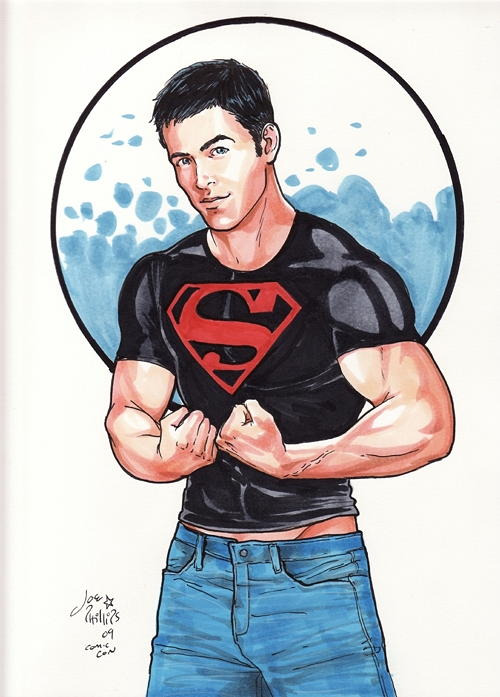
Sexy Superboy
It was while Phillips was working on a Superboy comic entitled "Superboy & Risk: Double Shot" that he first sexualized his artwork and dropped hints about homosexuality. Some readers picked up on this, one such person was art director of XY Magazine, Eriq Chang. Chang quickly offered Phillips a slot in the gay publication drawing a comic strip that would later become known as "Joe Boy".
Phillips was approached by the hardcore porn website Karas Adult Playground to produce adult animation, his first - Cumquest - was a spoof on the popular sci-fi series Star Trek. Another animation job followed for the gay porn website Absolutely Male for which Phillips created the animation The House of Morecock, a story about Jonas Morecock, a gay paranormal investigator. Morecock proved to be very popular and a set of 10 episodes was released on DVD by 10% Productions in 2001. In 2002 Morecock was nominated for a GayVN award in the category "Best Alternative Release"; it subsequently won in its category. A series of comic strip books followed alongside sets of postcard books. TLA Video lists Morecock as one of their all-time bestselling titles.

'A Boys Will Be Boys" illustration
In 2001 Phillips released "Boys Will Be Boys" - a calendar featuring original gay-themed art. In 2003 a book of the same title was released; it featured the art from the 2002 and 2003 calendars and incorporated some new original pieces. The calendar continues to be released annually.

another typical "Boys Will Be Boys" illustration
In 2006 with Adult Visual Animation, Phillips released his second adult-themed animated movie entitled Stonewall & Riot: The Ultimate Orgasm. The movie was a cross-over of the two genres Phillips was known for - Superheroes and work for the gay community. The movie was created entirely in 3D graphics. As with his previous movie, "Stonewall & Riot" was nominated for a GayVN award.
In 2013, Phillips animated and directed the official music video for UK Rock singer/songwriter Matt Fishel's single "When Boy Meets Boy". Described by Out Magazine as a "cute (and sexy)" love story "with a superhero twist", it shows an animated version of Fishel meeting a mysterious skater boy in a bar and concludes with a superhero fight and rescue sequence. British magazine The Gay UK called it "one of the best music videos we've seen in a long time." On 30 October 2013, the video for "When Boy Meets Boy" won the 2013 RightOutTV Music & Video Award for Best Pop/Rock Video. Phillips also created all the artwork for Matt Fishel's debut album Not Thinking Straight, which was released in April 2013 on Young Lust Records. The album booklet comprises 18 original illustrations by Phillips, each representing a different song's lyrics and portraying themes and issues surrounding young gay life, relationships and experiences. Phillips also created the artwork for Matt Fishel's 2013 singles "Radio-Friendly Pop Song", "When Boy Meets Boy" and "Oh Santa!"
Below: When Boy Meets Boy (3 mins 47 sec)
youtube


1987 – Steven Dehler is an American model, actor, and dancer. He has been described as the "the poster child for the modern male underwear model". He is a regular performer at The Abbey, a gay bar and nightclub in West Hollywood, California, and has been face of Marcuse Swimwear for their 2015 campaign.
With an active social media presence, Dehler has amassed over 142,000 followers on Instagram as of November 2015. Also in 2015, Dehler made the cover of Odyssey Magazine and played Mr. Coconuts on the Ellen Degeneres Show.
Steven Edward Dehler was born in Simi Valley. He is one of two children, with an older brother. While in elementary school, Dehler was the victim of bullying, where they would call him "Steven Gayler".
Dehler began his career working in West Hollywood. Originally he was a server in a small bar, then moved to doing bottle service at a club called Eleven. After winning a hot body contest at another club in West Hollywood, he was asked by a go-go dancer bookers saw Dehler and asked him to dance. After dancing at many locations around the area, by 2012 Dehler was dancing exclusively for The Abbey.
Dehler began his modeling career with Timoteo, an underwear and swimwear line. Along with Timoteo, he has also modeled for Marcuse, Freedom Reigns, and Marco Marco Underwear. Most prominently, Dehler has modeled for male underwear company Andrew Christian. One of the shoots he did involved a commercial called Freshman Car Wash, which also offered an unrated version online. Another was "Lick", which was shot with then-boyfriend (and fellow model) Montana Volby.
Well-known in the West Hollywood gay scene, Dehler is sometimes the subject of gossip columns

2009 – on the campus of Cornell University, a group of roughly 20 students lined up to hold a colorful banner that read "QUEER KISSIN' ... in progress" and then proceeded have a queer kiss-in. Direct Action to Stop Heterosexism sponsored the event, according to kiss-in participant Ashley McGovern. She explained that heterosexism is "kind of like homophobia except heterosexism has to do with all facets of society."
DASH didn't necessarily have sweeping or profound aims for the kiss-in, according to McGovern. "It was just supposed to be a fun action before Valentine's Day, it wasn't really a protest, it was more of a visibility thing ... just letting people know people are queer on campus and not afraid to be affectionate ... that was the goal — visibility and having fun," McGovern said.
Meanwhile at the University of Colorado in Boulder, Colorado, the Dalton Trumbo Fountain outside the University Memorial Center was the site of a mass make-out session titled "Make Out Stake Out." The "flash mob" of student couples of varying sexual orientations suddenly appeared at the fountain square, made out for two minutes — and then dispersed. "We're trying to remove the stigma that surrounds same-sex affection in public and, more importantly, the misconception that if you are queer and you are expressing affection in public that you are rubbing it in people's faces," junior Spencer Watson said.


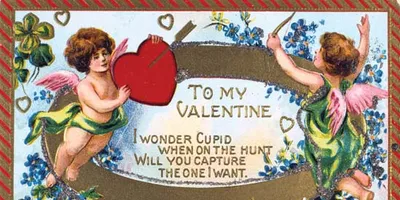
26 notes
·
View notes
Text
SAINT OF THE DAY (February 12)

St. Julian the Hospitaller, or "the Poor Man," came from a wealthy, noble family in the early 4th century and is a popular saint in Western Europe.
According to legend, while Julian was a baby, he was cursed to one day kill his own parents.
His father wanted him killed, but his mother kept him alive. When he was old enough to learn of the curse, he left his family to preserve their safety.
While he was hunting, his mother and father made an unexpected visit to his castle. His wife gave them one of the best rooms.
He received a vision from the devil that his wife was in his bed with another man, and he returned home to kill whoever was in his bed.
When Julian returned from his hunt and saw the two figures in bed, he assumed it was his wife with a lover.
In a jealous rage, Julian killed his mother and father.
Julian was so horrified upon learning the truth that he swore to devote the remainder of his life to good works.
He and his wife then undertook a pilgrimage to a distant country where he established a hospital.
The hospital was near a river that was frequently crossed by people prompted to travel by the Holy Crusades.
People frequently drowned crossing this river, so Julian took responsibility of ferrying travelers across and tending to the sick.
One night, the devil vandalized his house, and blaming it on those he helped, Julian said that he would never house anyone else ever again.
God showed up at his door, asking for help, and he denied Him.
After recognizing him, he retracted his statement and decided to help all those who needed it once again.
One night, thieves came into their hospital and killed Julian and his wife in the same way Julian had killed his mother and father.
“There were great miracles without end in that place and land,” recounts the legend. “So many that, as it pleased God, their bodies were brought to Brioude (France).”
St. Julian is considered the patron of ferrymen, innkeepers, and circus performers.
4 notes
·
View notes
Text
“I can only sit still for about six to eight weeks at a time,” said writer and literary critic Caroline Eden. An avid adventurer with a taste for local cuisine, Caroline is best known for her books Samarkand, Black Sea,and Red Sands, which blend travel writing and recipes from Eastern Europe, Central Asia, and beyond.
I happened to catch her at home, fresh off a trip through Moldova, Romania, and Ukraine that provided ample material for her recently launched newsletter, Journeys Beyond Borders. In Ukraine, she traveled south to Odesa to revisit the people and places she encountered in 2016–2017 when researching Black Sea. An updated edition of the book came out last November, which includes a new introduction reflecting on Russia’s full-scale invasion of Ukraine, a fascinating essay about eating lunch on the Bosphorus with Turkish ship spotter Yörük Işık, and, of course, an extra recipe.
Upon returning to Odesa in February, Caroline found that two years of all-out war had transformed the city deeply, though not beyond recognition. Retracing her steps, she visited the famous Pryvoz Market, where she met food vendors struggling to keep their businesses afloat in wartime. A couple of the restaurants Caroline had written about in her book had closed. And the locals she spoke to seemed worried about global attention shifting away from Ukraine. “I immediately noticed that there weren’t very many young people around because either they’ve left or they’re fighting, and the people who were there just looked exhausted,” she said.
Caroline said the mood in Odesa lifted around Valentine’s Day, though only briefly. “Every other person on the street was carrying a bouquet of flowers,” she recalled. “The hotel I always stay in went full-on for Valentine’s and had petals and hearts scattered [everywhere], confetti on the floor, and a full booking for the night. But the following morning, at 4:00 a.m., we were in the bomb shelter because the air raid sirens were going off.” (Russia’s missile and drone strikes on Odesa would only intensify in the weeks that followed.)
Once home from her travels, Caroline set about recording the audiobook for her forthcoming memoir, Cold Kitchen: A Year of Culinary Journeys, which will be released in the United Kingdom on May 9 (the U.S. edition hits stores in January 2025). Over the course of 12 chapters, each with a recipe at the end, Caroline takes readers inside her subterranean Edinburgh kitchen as she prepares dishes that evoke memories of different places that have influenced her thinking, work, and life. “It’s quite a meandering book,” she told me. “But the idea is that you can travel very well in the kitchen, with some imagination.”
The following story was written by Caroline Eden for Meduza’s weekly email newsletter The Beet. The accompanying recipe is from her book, Red Sands.
A trip to the Dordoi Bazaar
Kyrgyzstan might be landlocked, but Bishkek, the country’s capital, has a market forged entirely from shipping containers. Dordoi Bazaar is made up of thousands of these steel boxes covering the equivalent of 160 rugby fields. Flipped on their sides and doubled up, they make efficient shops, rigged with lights and padlocked securely at night. Distinct in spirit and commerce, Kyrgyzstan’s biggest bazaar offers particular insights into local trade wars, hospitality, food, and the new Silk Road. Among locals, it is sometimes called the Dordoi Republic.
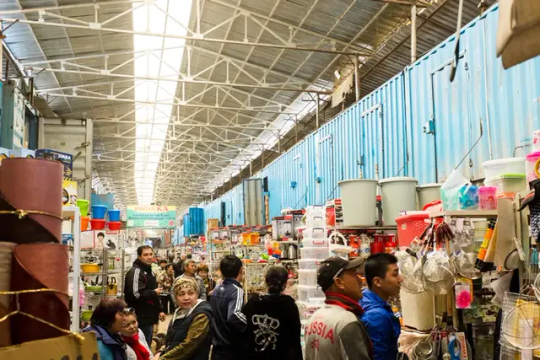
Thornton Cohen / Alamy / Vida Press
Dordoi employs 70,000 or so workers, officially and unofficially: drivers, unpackers, cooks, shopkeepers, tea boys, toilet attendants, security guards, waitresses, exchange tellers, and tailors. Pushers and pullers, handlers and dealers. All busy importing, exporting, and re-exporting. What may look anarchic at first is actually a very well-oiled operation. Money dictates order, and the bazaar is far too profitable to be chaotic. Dordoi has its own football (soccer) team and a mosque that is well-attended on Fridays.
Gold-painted statues of a man and two women flank the main entrance, a life-size monument to Central Asia’s “shuttle traders,” entrepreneurs who commute between different countries, buying goods in one location and then selling them elsewhere for profit. Memorialized, too, in gold, are piles of bulging suitcase-sized bags that each statue leans against. These familiar-looking squares of checkered woven plastic with handles are an instantly recognizable universal symbol of people on the move, of the entrepreneur and the newly arrived.
Food also plays a vital role. Inside, on an average day, you’ll see tea ladies weaving and waltzing through the alleys, their trolleys set up with tea, coffee, and condensed milk, pushing deeper into the twisting, gurgling intestines of the bazaar’s ever-hungry belly. Prams operate as moveable cafés, too, with Thermoses filled with tea and blankets swaddling freshly baked samsa and bread. Trolleys of kumys, fermented mare’s milk, go whizzing by, white and splashing. Sometimes a cart, displaying all the ingredients for ashlan-fu (a noodle dish) or a giant mound of plov, topped with quail eggs, is pushed along.

Caroline Eden
But one of the best places to eat is tucked between the China and Europe zones, where, if you search, you’ll spot a vendor tending to a tiny oven filled with rows of flaky samsa slowly turning ever more golden. Square rather than triangular, and filled with chicken rather than the more typical pumpkin, lamb, or mutton, the cook arranges his samsa in lines so their corners point upwards like a mountain range. Hot and moreish, the baker prepares 200 or so of these over the course of a lunchtime — and it is impossible to pass by without making a purchase.
The recipe below, from Red Sands: Reportage and Recipes Through Central Asia, from Hinterland to Heartland, is a nod to those delicious samsa served at the Dordoi Bazaar.
Grand Asia Express Samsa
Essentially triangular Central Asian turnovers, samsa are eaten everywhere and are typically filled with lamb, potato, or pumpkin. They make for a perfect snack, eaten hot on the spot. Here’s a quick recipe named after the legions of trucks and truckers that arrive and depart from Dordoi Bazaar, picking up a samsa or two for their long border-crossing journeys. The onion seeds make a nice addition, but they are optional.
(Twelve is a great number for a party or gathering but a lot for a small household. You can simply divide all the ingredients in half to make six.)
MAKES 12 LARGE SAMSA
400g/14oz chicken breasts
1 tsp olive oil
Sea salt and freshly ground black pepper
2 medium-size potatoes, peeled and roughly chopped
1 medium onion, roughly chopped
1 tsp ground cumin
1 x 500g/1lb 2oz packet of puff pastry
1 egg, beaten, for an egg wash
1 tbsp onion seeds (optional)
Preheat the oven to 180°C/350°F/gas mark 4 and prepare a small roasting tin by lining it with tin foil.
Put the chicken breasts in the tin, rub them with olive oil, and season with a pinch of salt and pepper. Roast them in the oven for 25 minutes or until cooked through. Set aside to cool, then roughly chop.
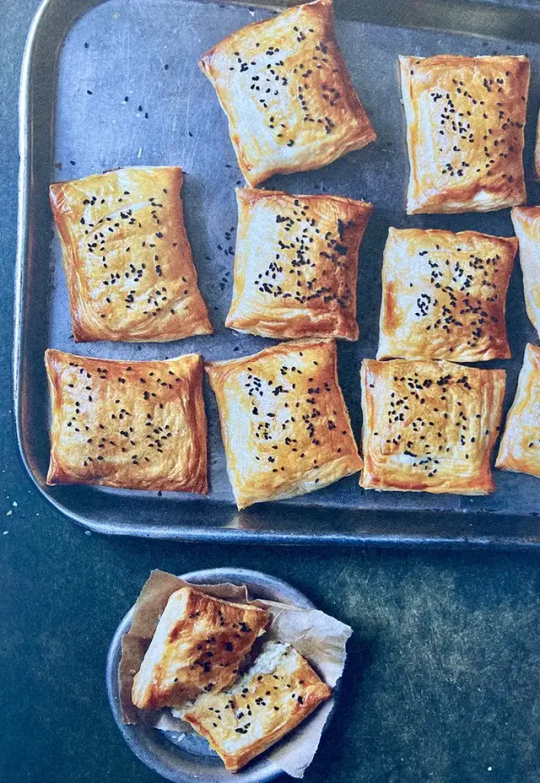
Ola O. Smit
Bring a medium saucepan of salted water to a boil and cook the potatoes for 15 minutes or until soft. Drain and set aside to cool.
Pulse the onion in a food processor until very fine, then add the cooled potatoes, and pulse again. Add the chicken, cumin, a good pinch of salt and pepper, and pulse again to bring the mixture together — you may need to scrape the sides of the bowl down as you go.
On a lightly floured surface, cut the pastry into quarters, then cut each quarter into thirds. Roll out each piece of pastry so that you have 12 rectangles, roughly 17 x 10cm (7 x 4in). Drop 40g/2 tbsp of the mixture onto one end of each rectangle, leaving a border around the edge. Brush the edges of the pastry with a little of the egg, then fold the other half over the top, pressing the edges together to seal well. Repeat with the remaining pastry. Brush the top of each samsa with egg and scatter over the onion seeds, if using. Place the samsas on the tray and bake for around 25–30 minutes until cooked through and completely golden.
5 notes
·
View notes
Text
5 minute read
From the kitchen table of the house she shares with her partner and (at times) their eight children, Lauren, 38, has been working with Claire to put pressure on the government to prevent sex offenders from changing their names after release. They have also had to fight to have their sister’s murderer placed on the sex offender register.
In April, they travelled to London to meet Damian Hinds, minister for prisons, parole and probation, to explain their concerns that weaknesses in the law make women and children more vulnerable when sex offenders are released from prison.
Lauren Holmes was 11 when she discovered how her sister, Collette, had died. There were woods near the family home in Corby in Northamptonshire, and Lauren had ignored her mother’s warning that they were unsafe.
“We knew we weren’t allowed to go there,” Lauren remembers, “but we did, and we got chased by a local lad. Two of my friends ended up in hospital getting thorns removed because they’d tried to escape through the brambles. That evening, everyone’s parents gave us a real rollicking, but my mum was just silent. I couldn’t understand why she wasn’t shouting. I was sent to my room and she came in and threw a load of newspapers on my bed, and she said: ‘This is why you’re not allowed to go into the woods!’ I felt shocked and guilty. It was a hard way to find out.”
The newspapers explained that a local man named Adam Stein had abducted six-year-old Collette Gallacher in February 1986 as she waited for a bus to take her to school, the same school where her mother worked as a playground assistant and dinner lady. Corby in the 1980s was a much smaller place than it is today. Struggling with the fallout of the closure of the British Steel plant, which had been Europe’s largest steelworks, there was high unemployment – but there was also a sense of community in the streets around the Gallachers’ home. “Everyone knew each other,” Lauren says. It was not unusual for a six-year-old to be sent off to school alone.
On the day of the abduction, “someone asked my mum where Collette was, and that’s when they realised something wasn’t right,” Lauren says. The search for Collette lasted five days, and Stein was one of the many locals who volunteered to look for her, before her body was found in the attic of the house that he shared with his wife and young son. Stein admitted rape as well as murder, but the sexual assault charge lay on file – a decision sometimes taken if a defendant has also pleaded guilty to more serious charges. Lauren and her younger half-sister Claire believe this was in order to spare the family from sitting through details of the attack in court. Stein was jailed for life and told he would serve a minimum of 20 years. Thirty-seven years later, Collette’s sisters are still fighting to make sure he does not escape justice.
Claire Holmes was not yet born and Lauren was only 15 months old when Collette was killed, but her murder still dominates their lives. Their mother, Karen, did her best to shield them from what had happened but when Claire, now 32, was nine or 10, she stumbled across a box of newspaper cuttings. “I was in my mum’s room having a nosy around, as I shouldn’t have done. We always knew we had a big sister, that a bad man had taken her, but it was a taboo subject. My mum still struggles to say Collette’s name. My grandad had to explain it all.”
From the kitchen table of the house she shares with her partner and (at times) their eight children, Lauren, 38, has been working with Claire to put pressure on the government to prevent sex offenders from changing their names after release. They have also had to fight to have their sister’s murderer placed on the sex offender register.
In April, they travelled to London to meet Damian Hinds, minister for prisons, parole and probation, to explain their concerns that weaknesses in the law make women and children more vulnerable when sex offenders are released from prison.
Lauren, who works as a carer at a home for adults with a rare genetic condition, feels she has become a part-time detective, working with the local Corby journalist Kate Cronin to investigate why her sister’s murderer was sent back to prison after his release in 2016. It appears this was connected to driving offences, and she discovered he had changed his name and begun a relationship with a vulnerable teenager during the short period he was free. Claire has begun a degree in criminology, spurred on by her concerns about flaws in the justice system.
The sisters want to make it clear that their activism does not stem from vindictiveness. “This is not a witch-hunt. We hoped he would be rehabilitated in prison, but everything we now know suggests that hasn’t happened,” Claire says. “The latest parole statement that we have says that he is still having bad thoughts about children, and not understanding the consequences of his actions. From all the information we have, he does not seem to be a man who has changed.”
They are cautiously optimistic that their campaign may be getting somewhere. In March, the Labour MP for Rotherham, Sarah Champion, organised a debate on sex offenders’ name changes, while Bolsover’s Conservative MP, Mark Fletcher, had a 10-minute-rule bill on the same subject; both argue that it is too easy for sex offenders to conceal their identities.
“A sex offender can change their name and with little difficulty receive a passport or a driving licence with their new name,” Fletcher told MPs. “At no point are you asked if you have a criminal background. In some cases this can lead to a DBS check under their new identity.” A DBS, or Disclosure and Barring Service, check is required for some jobs or voluntary roles, particularly in healthcare or in positions that involve working with children.
Collette’s sisters did not intend to devote so much of their lives to campaigning, but the target of their concern has evolved over the years. Stein was refused parole several times before being released in 2016 and returned to prison in 2017. He was released again in 2021 and sent back in July 2022. After his first release, they were dismayed to discover that he had not been placed automatically on the sex offender register. Their campaigning resulted in his name being added, but they are still uncertain about whether the initial failure was because he did not have a conviction for rape or because the offence predated the launch of the register.
A newspaper article by Cronin prompted a woman to get in touch to say that while he had been out of prison in 2016, Stein, then 58, had changed his name and struck up a relationship with her, when she was 18. He admitted that he had been in prison after killing a child, but told her it had been an accident.
The sisters were concerned that Stein’s ability to change his name made it easier to conceal his past. “You shouldn’t be able to hide when you’ve committed crimes of this nature. That should be something that you carry for the rest of your life,” Claire says.
The Safeguarding Alliance warns that the child sexual offenders’ disclosure scheme (also known as Sarah’s law, named after eight-year-old Sarah Payne, who was murdered by a paedophile in 2000), which allows parents to check if a person has a record for child sexual offences, becomes useless if the offender has changed their name.
Asked why this weakness has not already been fixed, Fletcher said this was “a bit of a head-scratcher”. There is the possibility that post-prison rehabilitation would be undermined for those who have reformed and want a new start, but the government is not making this case, just arguing that sex offenders are already required to notify the authorities if they change their names and face an extra five years’ imprisonment if they fail to do this within three days of the change.
Campaigners point out that many fail to do so. Freedom of information requests from the Safeguarding Alliance show that about 900 sex offenders went missing between 2017 and 2020, while 16,000 had in some way breached their notification requirements in the past five years. As Fletcher told MPs: “It doesn’t take a genius to realise that sex offenders are not the most trustworthy group.”
Champion, meanwhile, has pointed out that some perpetrators change their name before being formally charged with an offence, “meaning their birth name remains unmaligned”.
Collette’s sisters are hopeful that reform may be included in the victims and prisoners bill currently going through parliament. In the meantime, they have been working with Cronin to try to get more information about whether Stein still poses a threat to the public ahead of his next possible release in 2024.
Cronin’s attempts to obtain more information about him have been complicated by the name changes. “It’s not about pitchforks. It’s about keeping women and girls safe,” she says.
The family are dismayed that they are still fighting to ensure Stein is properly monitored after his release. “His name is constantly in our mouths,” says Claire. “It would have been lovely to know that he had been released and quietly got on with his life. It does happen. People do change their lives – but that’s not been the case. We feel like we can never have peace.”
10 notes
·
View notes
Text
The Weekend Update: February Weekends!
The past few weekends have been really fun and exciting. I want to take you guys weekend by weekend to show how easy it is not only to travel around Europe, but also the benefits of staying in your home away from home for a weekend.
2/6
My first weekend was actually a pretty unexpected travel weekend. I was in Prague for less than a week but remembered my mom was going to London on a work trip. I knew since we were so close, I had to visit! On Saturday morning I found a flight that would leave to London Sunday morning, with a return flight to Prague the following day (Monday) in the afternoon. Even though it was only 24 hours I was in London, we had an amazing time together and I would not trade the experience for the world. I have been to London once before with my family 7 years ago and being back made me realize how much I remembered from my previous trip.

When I arrived in London, we went and grabbed some fish and chips, then went on our own walking tour of the classic London attractions: Buckingham Palace, Big Ben, Westminster Abbey, the London Eye, and finished up at a Pub watching a football game, yes that’s soccer :)
By the following morning, it was already time to go on the hour Uber ride to the airport. Even though it was for one real day, I would not want to change it for the world. Having my mom for a little bit, really helped me adjust completely to my abroad lifestyle and I am so fortunate to have the opportunity to see her so soon after going abroad.
2/10-2/12
The following weekend was also a last minute type of trip. Ashley and I were looking at inexpensive locations near Prague for both travel and accommodations once arriving in the city. We realized that the best location would be in Berlin, Germany.
To preface, I was excited to see Berlin but also had an underlying eeriness to it since I am Jewish and Berlin was the center of the Nazi Party during WWII. Additionally, I was excited to go because when my grandfather was in the Soviet army, he was stationed throughout East Germany, specifically Berlin and Dresden, which was pretty much the exact bus route I took.

Once arriving in Berlin, I already had unwritten “beef” with the city, but I tried not to let it influence my opinion of my trip there. We got to our hostel and ended up becoming good friends with our roommate, her name was Paula and from Argentina. She gave us recommendations throughout the city and we started exploring!
We got to see the Brandenburg Gate, the Jewish memorial in Berlin, as well as the main Cathedral.

I wish we could have gotten to see more (including the wall) but it was pouring rain the full day we had there and it was impossible to get around. Definitely have to go back for another trip.
Additionally, nightlife and techno is something that is a part of Berlin culture. We went to a bar and ended up also making friends with some girls from Berlin as well as Ukraine.
Side note: in Prague too, there are a lot of Ukranians, it is absolutely horrific what is going on two countries away from me too.
On our walk though, we passed by the Russian embassy in Berlin. They had a recreation of Alexi Navalny’s jail cell as well as a Ukrainian memorial. Walking around Berlin made me realize how close I am to the conflict and how some of the amazing people I am meeting are completely displaced from their homes with war terrorizing their homeland.
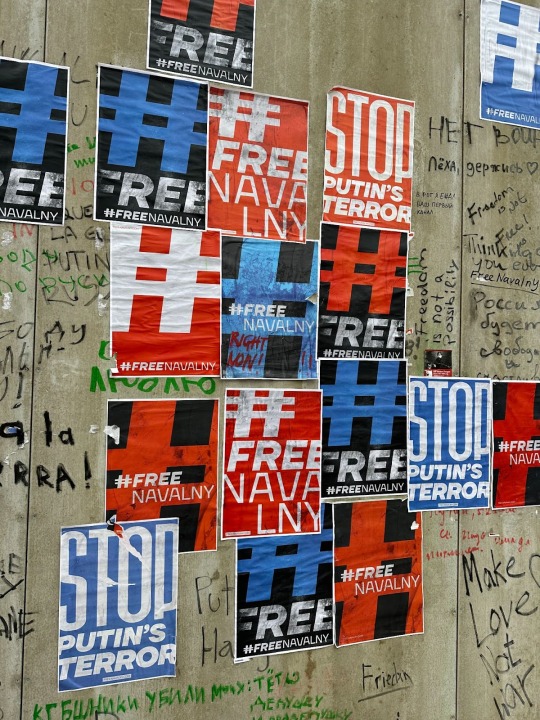
2/17-2/20
This weekend was a really special weekend for me. One of my closest childhood friends, Gianna, was coming to visit! She is studying abroad in Edinburgh this semester and came to Prague for the weekend…. thus, tour guide Hannah came out!!!!

We went to Prague Castle, the top of the clock tower, and honestly I went to more tourist places during this weekend than before. We went to different markets and would not trade the experience.
I felt like walking around the city with Gianna helped me gain a new perspective of how amazing Prague really is. It is a truly hidden gem in Europe and everyday here I learn something new about the city and the Czech culture.
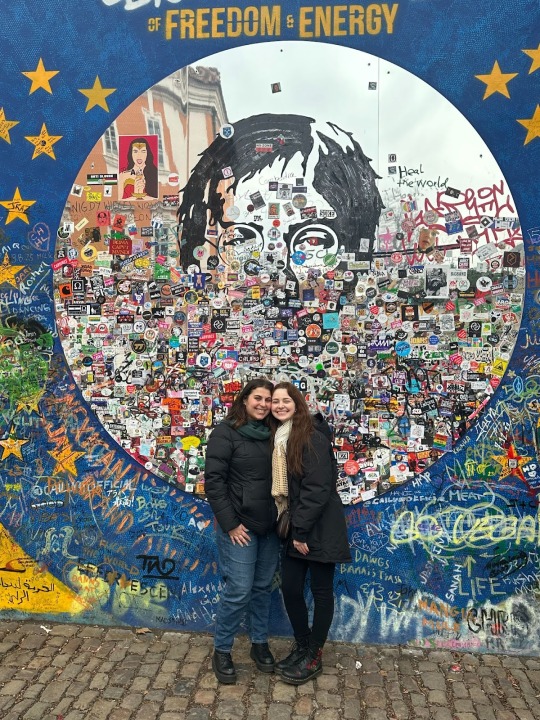
Having her here was also like another piece of home was with me. Seeing how much she is thriving in Scotland prompted me to book a flight to visit her!!
2/24-2/25
Last weekend in February calls for the monthly CEA excursion, these excursions are included in our study abroad tuition which is really nice to have! This weekend we went to Cesky Krumlov, the whole town is a UNESCO World Heritage site!
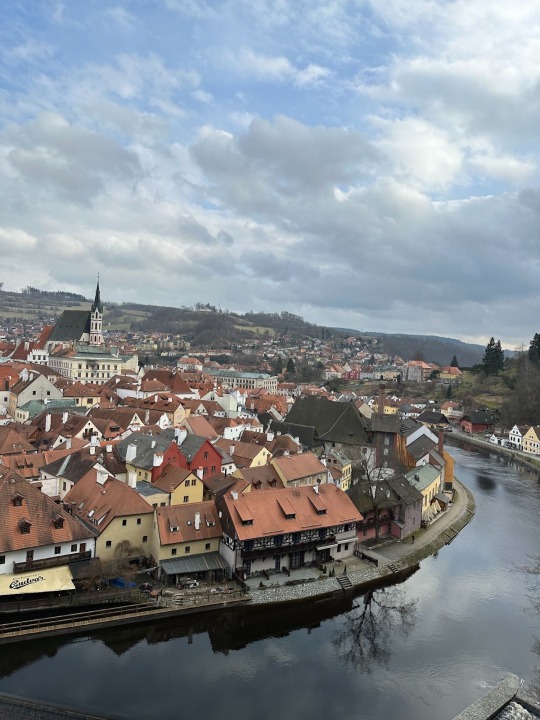
It is a two and a half hour bus ride and I got to be able to go with my entire program. It was a really nice way to get introduced to those in my program whom I do not have classes with.
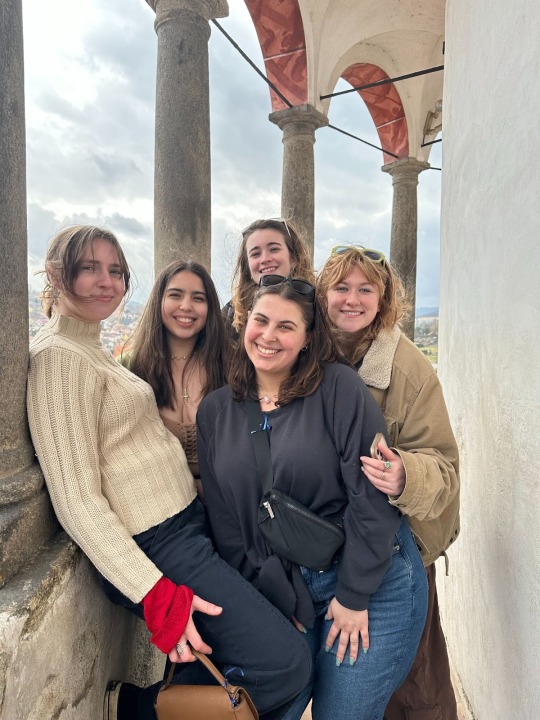
When arriving we went around the town to explore and then had tours of the castle tower and the theater there that is in complete Baroque style.
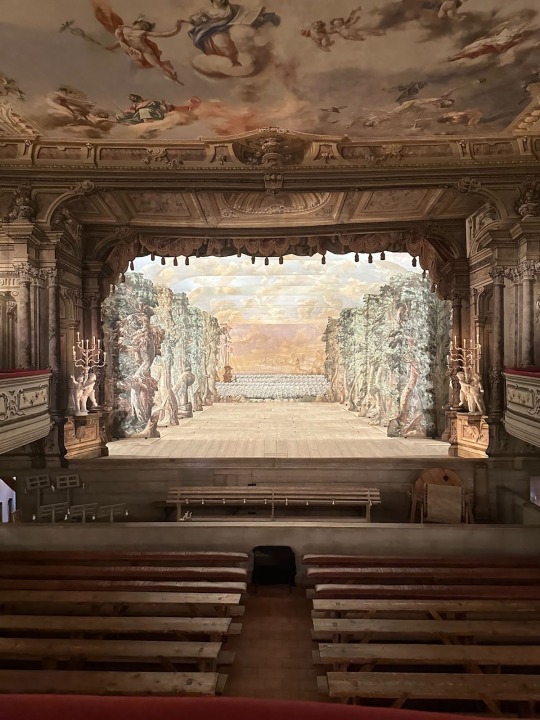
At night, we went to a cafe and then a typical Czech restaurant, where I had the goulash :)
The next day was really cool… we didn’t know the weekend that we were there, Cesky Krumlov had their annual pig slaughtering event. No pigs were harmed during the event but an entire street had tables and had a whole pig roast and the pig that was used was made into many different traditional Czech food items, my favorite being the pate given

I felt really fortunate to be able to experience this cultural celebration and it was a great way to finish off the weekend!!
This next month is also filled with a lot of travel… Current travel plans for March include:
London again (for 12 hours this time!)
Lake Como and Venice, Italy
Dublin, Ireland
Salzburg and Hallstatt, Austria
Edinburgh, Scotland
See you in the next blog!
3 notes
·
View notes
Text
For the upcoming energy crisis in Europe, unusually cold winters, and travells to a cold and dark place, here's some tips for dealing with cold/dark winters:
(Disclaimer: I live in Sweden, which isn't super cold bc of the Gulf Stream and climate change, but it's pretty normal that temperatures go down to -15 or -20°C every year (yes I'm something of a southerner), which is a lot colder than in a lot of places)
1. Layers.
1.a) Layer your clothes. The clothes themselves aren't what keeps you warm, it's the air in between that does. Your body heats up the air in between the layers, and that air then warms you. (Basically, I might have gotten a few things wrong here)
1.b) Same goes for blankets. (If you use a weighted blanket, maybe don't, the layers will likely be heavy anyways, so it will have a similar effect.) Add another blanket if you have one, i use a thick-ish bedspread, your extra bed sheets or a coat would also work. Heck, if you really need to you can use a tablecloth.
2. Water is cold. Just like it's easily gets warm in warm weather, it easily gets cold in cold weather. Especially if it's below zero.
2.a) Don't sweat. You don't want to freeze, but absolutely don't get so warm you start sweating. It's better to be a little bit cold than a little bit warm, because if you're a little bit warm you'll be very cold soon. If you're exercising in the cold, make sure to have something you can change to before going home (if you're not by your house), and take a shower as quickly as possible when you get inside. Use wool or polyester with the same effect, to not have the sweat close to the body (especially when exercising, but also just in general).
2.b) Which moves us to the next thing: showers. Just make sure you get properly dry before putting on clothes. And if you go outside in less than zero degrees with wet hair, it might freeze.
2.c) I've seen a lot of people blow in their gloves or on their hands when they are cold, don't. Your breath has a bunch of water particles, and this means they will get a lot colder than they where before. Instead put them in your armpits. Preferably under your jacket. They won't smell or become wet because you shouldn't be sweaty, and you will only put them under the second layer, just in case.
3. How your body responds. Idk what to title this.
3.a) Your immune system is worse when you're cold. I don't know the exact science, but I think it was something about the body putting more energy into keeping your body temperature, and therefore having less to fight viruses and stuff. That's why the flu and the cold and stuff is such a February thing here. There is even slang used among parents with young children for the month that stems from how much they need to stay at home and take care of their sick kids this month.
3.b) On a similar note: every medical condition you have is gonna be worse. Asthma? Worse. Injury? Worse. Chronic illness? Worse. Not very flexible? Now you'll be less. I don't know if things actually heals slower or if it has any actual effect on us medically, so science tumblr are welcome to fill me in on that.
3.c) Your hands get drier. That might go back to being sick easier, and therfor you just kinda learn to wash your hands more in flu season. It was actually all right during the pandemic though, I think. That was definitely because people actually stayed home when sick, though.
4. General living space stuff. I lived in a badly heated house before, and had the coldest room, so here's just things I did to keep it warm, among other things i didn't do but probably works.
4.a) Cover the windows. I had a theory that the let most the heat out, and when I covered them I felt a difference. I don't know what is the best way, but I used the built-in (dark) ugly blinders, as well as my (white) good-looking curtains combined with my opened wardrobe door, in order to cover the whole window.
4.b) Turning on the light (even LED, but that might have been placebo) felt like it made a difference. And a PC or other technological thing that gets hot works. This is probably gonna show on your electricity bill, though.
4.c) If you cooked using the oven, leave it open afterwards (when you've turned it off). This will heat at least you kitchen. Don't close the oven until it's room temperature. This is also why I would suggest cooking mostly oven-meals, so you can do this a lot. (But remember that the door can still be hot even if it's been opened.)
4.d) Heaters that only require an electrical outlet, and can be moved around per your wish. I don't think this needs an explanation. Just be aware that if you're in a place that usually isn't cold, they might run out pretty quickly.
4.e) The things with windows probably works on walls to, if you live somewhere the walls are badly isolated.
5. Car stuff. You might be surprised by a lot of snow and icy roads, or your car could malfunction with help having a hard time getting to you.
5.a) No matter where you're going and what you plan to do there, always have warm clothes with you. You can leave them in the car while you're doing the thing, but always have them in case of emergency on the road.
5.b) Always keep a shovel in your car, whether it is for digging yourself out of a snow storm, making a temporary camp, or there just being a lot of snow on a small road you hadn't anticipated, you want to have it there. You probably won't have to use it if you're where I live, but it doesn't hurt adding it to your normal tool box (bc you should have one in the car in general).
5.c) First-aid-kit and tools. This is just a good thing in general, but I especially suggest adding an emergency blanket/space blanket and wool socks.
5.d) Winter tires. Idk how to translate it. If you google it, it probably shows up. Basically tires that are designed specifically for icy roads.
6. General clothes stuff. Beyond layers, there are other things that helps.
6.a) Wear wool and polyester with the same function. Cotton is bad. Cotton sucks up water (including sweat), and makes you cold. Wool and polyester (specifically the type of breathable technology used in sportswear and polyester-based thermal underwear. Most polyester will not do the trick) doesn't. Anything breathable (cotton is very much not) works. I'm not sure I can stress this enough. If you are wearing clothes of the right temperature, cotton is fine though. I think linen may be better, because I have a vague memory of someone saying it's pretty breathable, but if someone else can confirm that's great.
6.b) Sleep in socks. I don't think this really needs an explanation, but it's seriously what has made the biggest difference for me. Not adding more other clothes or blankets, but adding socks.
6.c) If the gloves have fingers, they are probably cold. Idk why but keeping your fingers together is much warmer than just warming them on their own. If you only have gloves with fingers, a good way to keep them warm is to close your fist inside of it (and keep the fingers empty). Idk if that made any sense, but I'm sure you'll figure it out.
7. Mental health. Your mental health will probably be more fragile, and you will definitely be more tired. These probably have to do with each other. (This is specifically for people that move to a country with much darkness in the winter.)
7.a) I think it was partially about the lack of vitamin D that comes with less sunlight (?). So if you don't eat meat (especially if you're vegan), try the pills with it. Vitamin D deficiency is a genuine problem here, so make sure you get everything you need.
7.b) You know how you weren't allowed to study with the lights off in the classroom when you were a child? Yeah, your teachers were right. Darkness makes you more tired, and you will likely spend most of the daylight hours indoors (whether it's for work or school). Take a lunch walk if you have time, even though it's cold.
8. You think the sun is warm? Wrong. It doesn't have nearly the energy to warm you up. Instead, the more clouds the warmer your day will be. This is because the clouds trap the heat, kinda similar to global warming, except normal and on a much smaller scale. Go for the longest walks when it's cloudy (if you can), unless you enjoy freezing your ass off. Like you will still freeze your ass off, but a little bit less -- just so we're clear. (Also idk if this is because it's cold or if it's because of distance to sun, which also makes it cold. If this didn't make any sense: I wonder if this depends on temperature (like there's that on magic temperature where the sun is suddenly colder) or if it's a geographical thing (like it's a certain location where the north/south pole is so far the sun stops having an effect))
1 note
·
View note
Text
The Best Time to Visit Croatia A Seasonal Guide

Croatia, with its stunning coastline, historic cities, and picturesque islands, is a top destination for travelers. The best time to visit Croatia depends on what you want to experience, whether it's sunny beaches, cultural festivals, or outdoor adventures..
Spring (March to May)
Pros:
Mild Weather: Spring in Croatia offers mild temperatures, ranging from 10°C (50°F) to 20°C (68°F), making it ideal for sightseeing and outdoor activities.
Fewer Crowds: Tourist spots are less crowded compared to the summer months, providing a more relaxed experience.
Blooming Nature: The countryside is lush and green, with wildflowers in full bloom, perfect for nature walks and hiking.
Cons:
Cooler Sea Temperatures: The Adriatic Sea might still be too cold for swimming.
Highlights:
Plitvice Lakes National Park: Witness the stunning waterfalls and clear blue lakes amidst spring greenery.
Dubrovnik: Enjoy the historic sites without the summer crowds.
Summer (June to August)
Pros:
Warm Weather: Ideal for beachgoers, with temperatures ranging from 25°C (77°F) to 35°C (95°F).
Festival Season: Numerous cultural festivals, including the famous Dubrovnik Summer Festival and Split’s Ultra Europe Festival.
Vibrant Nightlife: Coastal towns like Hvar and Split are buzzing with nightlife.
Cons:
Crowds and Higher Prices: Popular destinations can be very crowded and accommodation prices peak during these months.
Heat: It can get very hot, especially in July and August, which might be uncomfortable for some travelers.
Highlights:
Dalmatian Coast: Explore beautiful beaches and crystal-clear waters in places like Hvar, Brac, and the Makarska Riviera.
Island Hopping: Perfect time for sailing and discovering the many islands.
Autumn (September to November)
Pros:
Pleasant Weather: September still offers warm temperatures suitable for swimming, while October and November are cooler but comfortable for sightseeing.
Reduced Crowds: Fewer tourists make it easier to enjoy popular sites.
Harvest Season: Great time to experience local food and wine festivals.
Cons:
Shorter Days: Daylight hours decrease as the season progresses.
Unpredictable Weather: Rain becomes more likely in late autumn.
Highlights:
Istrian Peninsula: Known for its truffle season and wine harvests.
Zadar and Rovinj: Explore these charming coastal cities with fewer tourists around.
Winter (December to February)
Pros:
Lower Prices: Accommodation and travel costs are significantly lower.
Festive Atmosphere: Christmas markets in cities like Zagreb offer a unique experience.
Cons:
Cold Weather: Temperatures can drop to 5°C (41°F) or lower, particularly inland.
Limited Activities: Some tourist attractions and ferry services may be closed or reduced.
Highlights:
Zagreb: Renowned for its festive Christmas market, voted one of the best in Europe.
Skiing: Head to the mountainous regions for winter sports.
Conclusion
The Best time to visit Croatia ultimately depends on your preferences. For beach vacations and vibrant nightlife, summer is ideal despite the crowds. Spring and autumn are perfect for a blend of pleasant weather and fewer tourists, offering the best conditions for exploring the country’s natural beauty and historical sites. Winter, while colder and quieter, presents a unique charm with festive celebrations and lower travel costs. Whenever you choose to visit, Croatia's diverse offerings ensure a memorable experience.
0 notes
Text
Artfully Yours - Exploring the Canvas of the Best Travel Destinations in Kerala | Explurger
Kerala, dubbed “God’s Own Country,” offers stunning scenery, from dense forests and tranquil backwaters to majestic peaks and sun-kissed beaches. Its cuisine, rich in fermented foods, is gut-friendly, while its culture, vibrant festivals, and traditional practices make it a must-visit destination. If you’re wondering where to start, here are some of the best tourist attractions in Kerala.
1. Wayanad
Wayanad, perfect for a weekend getaway, boasts postcard-perfect landscapes and soothing weather. Each season showcases its unique beauty. Meet local tribes and explore their lifestyle.
Activities & Places to Visit: Edakkal Caves, Banasura Sagar Dam, Chembra Peak Trek, Soochipara Falls, Pookode Lake, Bamboo Rafting at Vythiri, Tea Tasting.
Best Time to Visit: October to February.
2. Alleppey (Alappuzha)
Known as the "Venice of the East," Alleppey is central to Kerala’s backwaters, surrounded by marshlands, lagoons, canals, and coconut groves. Experience the backwaters authentically by staying in houseboats.
Places to Visit: Vembanad Lake, Alleppey Beach, Punnapra Beach, Ambalapuzha Sree Krishna Temple, St. Mary’s Basilica, Krishnapuram Palace, Bay Island Driftwood Museum.
Best Time to Visit: October to February.
3. Munnar
Munnar is a sought-after honeymoon destination with hills, tea plantations, and scenic views. It attracts those seeking solitude, relaxation, and peace. A visit to the tea plantations might turn you into a tea lover.
Places to Visit: Rajamala, Eravikulam National Park, Cheeyapara Waterfalls, Devikulam, Kundala Lake, TATA Tea Museum, and more.
Best Time to Visit: October to February, and March to June.
4. Cochin
Nicknamed the "Queen of the Arabian Sea," Kochi is a blend of traditional and modern lifestyles, and it’s also Kerala's financial, commercial, and industrial hub. Fort Kochi showcases cultural performances like Kalaripayattu and Kathakali.
Places to Visit: Vasco Da Gama Square, Kodannad Elephant Training Centre, Vypeen Island, Marine Drive, St. Francis Church, Lulu Mall, Kerala Kathakali Centre, and more.
Best Time to Visit: July to April.
5. Kovalam
Kovalam, known for its pristine beaches and endless shoreline, is less touristy than Goa. It offers aesthetic cafes and hotels with rocky shores and peaceful swims, surrounded by mangroves and estuaries.
Places to Visit: Shri Padmanabhaswamy Temple, Vellayani Lake, Lighthouse Beach, Valiyathura Pier, Kovalam Beach, Neyyar Dam, Halcyon Castle, and more.
Best Time to Visit: September to March.
6. Thrissur
Thrissur is culturally the best travel destination in Kerala, filled with temples and famous for the Thrissur Pooram festival. It’s a religious hub for Hindu devotees and a global attraction for its lively festivals and decorated elephant processions.
Places to Visit: Athirapally Waterfalls, Peechi-Vazhani Wildlife Sanctuary, Vadakkunnathan Temple, Nattika Beach, Thrissur Zoo, and more.
Best Time to Visit: Throughout the year.
7. Thekkady
Thekkady, evergreen throughout the year, is known as the Spice Capital of India. Famous for Periyar Lake and Periyar Tiger Reserve, it offers jungle safaris, elephant rides, and visits to aromatic spice plantations.
Places to Visit: Periyar National Park, Periyar Lake, Spring Valley Mountain, Kumily, Vandiperiyar, Grampi, and more.
Best Time to Visit: Year-round.
8. Varkala
Varkala feels like a slice of Europe with beautiful beaches and cliffs facing the Arabian Sea. It’s a surfing hotspot with many schools and home to the ancient Janardhanswamy Temple.
Places to Visit: Varkala Cliff, Varkala Beaches, Papanasham Beach, Anjengo Fort, Janardhanswamy Temple, Kappil Lake, and more.
Best Time to Visit: Year-round.
Kerala offers diverse cuisine with both vegetarian and non-vegetarian options, often served on banana leaves, known as Sadya. The state's approach to food aligns with the Japanese concept of “Hara Hachi Bu,” advising to eat until 80% full.
Whether it’s beaches, mountains, or backwaters, Kerala promises picture-perfect scenes, soulful music, and gastronomic delights. Pack your bags for an unforgettable journey, but leave room for memories you’ll cherish forever. Explore the rich activities and natural beauty of this vibrant haven using the best travel apps.
0 notes
Text
The Ultimate Guide to Shoulder Season Travel: Best Places to Visit by Month
Traveling during the shoulder season is a savvy way to explore the world. These periods, nestled between the peak and off-peak times, offer travelers the best of both worlds: favorable weather, thinner crowds, and often, a gentler hit to the wallet. Each month unveils unique destinations where the conditions are just right for adventure, cultural immersion, and relaxation. Here's a comprehensive month-by-month guide to planning your travels in the shoulder season, ensuring you get the most out of every trip.
Embark on a Journey Through Seasons and Continents
January: A Southern African Adventure
Kick off the year with the warmth of Southern Africa. South Africa basks in its summer glory, making it perfect for beach lovers and wildlife enthusiasts. Botswana's green season paints the landscapes with life, offering spectacular safari experiences, while Namibia's milder desert climate allows for comfortable exploration of its otherworldly terrains.
February: Southeast Asian Wonders
February is the time to wander through Southeast Asia. From the cool but pleasant north of Vietnam to the dry and sunny south, the weather is inviting. Cambodia and Thailand offer clear skies for temple touring and island hopping, while Singapore shines with urban explorations minus the peak holiday throngs.
March: Blossoms and Autumn Hues
Witness Japan's iconic cherry blossoms or trek Nepal's clear paths. South Korea greets spring with vibrant celebrations. Down under, New Zealand and Australia showcase the beauty of autumn, providing a cooler yet still sunny escape.
April: From Islands to Ancient Lands
April's gentle weather is perfect in the Philippines for beach enthusiasts, in Peru for the Andes explorers, across Europe for early spring charm, in Egypt for historical sojourns without the scorching heat, and in Australia for those seeking milder autumn adventures.
May: Pre-Summer Escapes
Indonesia enters its dry season, Hawaii offers near-perfect climate conditions, Nicaragua starts warming up, the Mediterranean beckons with pre-summer warmth, and Iceland extends its daylight for endless exploration.
June: Cultural Riches and Natural Splendors
Experience Turkey and Georgia in their warm embrace, perfect for delving into history and nature. Costa Rica and El Salvador showcase their lush landscapes and biodiversity in the green season.
July: Monsoon Magic
India, Sri Lanka, and the Maldives offer a different perspective with the monsoon season—lush landscapes, fewer crowds, and unique travel deals.
August: Central Asian Charm
Explore the heart of the Silk Road in Kyrgyzstan, Uzbekistan, and Kazakhstan, where comfortable summer weather makes for an ideal exploration of ancient cities and stunning vistas.
September: Fall's Early Glories
The Dolomites, Mexico, Canada, Norway, and the Mediterranean are spectacular in September, with mild weather perfect for outdoor activities and enjoying the early signs of autumn.
October: A Kaleidoscope of Experiences
From the autumnal charm of Western Europe to the diverse climates of Brazil and the United States, and the beginning of the dry season in Colombia, Thailand, and Laos, October offers a palette of travel experiences.
November: Adventures and Explorations
As the year winds down, Morocco and Egypt cool down but remain sunny, Nicaragua and Patagonia burst with life, and Jordan and Oman invite desert explorations.
December: Winter Wonders and Tropical Retreats
Eastern Europe dazzles with festive spirit and snowy landscapes, while Kenya and Tanzania are prime for safaris. Panama and Guatemala offer a warm escape from the winter chill.
Wrapping Up the Year with Unforgettable Journeys
Traveling during the shoulder season allows for a deeper connection with the destinations, free from the constraints of peak tourist periods. Each month offers a gateway to diverse cultures, climates, and experiences. By choosing your destinations wisely based on the time of year, you can enjoy all the benefits of off-peak travel without compromising on the experience. From the cherry blossoms of Japan to the ancient wonders of Egypt, and from the green landscapes of Central America to the festive markets of Eastern Europe, there's a world waiting to be explored, with each month revealing its own unique charm. So pack your bags, and let's set off on a year-long adventure that promises the beauty of the world in the shoulder season.
MICHAEL SHANE STEPHENS
Curated Global Travel An affiliate of Protravel
[email protected]
310.691.7461 curatedglobaltravel.com
Copyright © 2024 Global Travel Collection
1633 Broadway, New York, NY 10019.
0 notes
Text
Optimal Timing for Your Prague Adventure: When to Visit for the Best Experience

#PragueExploration #PristinePrague #EnchantingPrague #HistoricPrague #DiscoverPrague
The best time of year to visit Prague really depends on what you're looking for. Here are some things to consider for each season:
- Spring (March - May): Spring in Prague can be quite beautiful, with flowers blooming and mild temperatures. However, keep in mind that it can also be quite rainy, and the crowds start to pick up in May.
- Summer (June - August): Summer is peak tourist season in Prague, with lots of people visiting the city to enjoy the warm weather and outdoor activities. The days are long, with daylight until around 10 pm, making it a great time to explore the city.
- Fall (September - November): Fall is a lovely time to visit Prague, with the trees changing color and fewer crowds. Temperatures start to drop in November, but it can still be pleasant for sightseeing.
- Winter (December - February): Winter in Prague can be magical, with Christmas markets, snow, and festive decorations. However, it can also be quite cold and dark, with shorter days and fewer outdoor activities.

Overall, the best time to visit Prague is in the shoulder seasons of spring and fall, when the weather is mild and the crowds are smaller. However, if you don't mind the crowds and want to enjoy the warm weather and outdoor activities, summer can also be a great time to visit.

Hotels and Hostels in Prague
Booking.com is available in 43 languages and offers more than 28 million reported accommodation listings, including over 6.6 million homes, apartments, and other unique places to stay.
TripAdvisor is the world’s largest travel guidance platform. With more than 1 billion reviews and opinions of nearly 8 million businesses, travelers turn to Tripadvisor to find deals on accommodations, and book experiences.
Klook is a booking platform on which travelers can book hotels, cars, tours and activities, tickets to attractions, and shows at great prices.

Hotellook is a service that helps you find and compare prices on hotels around the world, provided by a leading reservation system. Today, Hotellook.com offered to put together information on more than 250,000 hotels in 205 countries.

Hostelworld, the global hostel-focused online booking platform, inspires passionate travelers to see the world, meet new people, and come back with extraordinary stories to tell. Hostelworld has more than 13 million reviews across over 17,000 hostels in more than 179 countries, making the brand the leading online hub for social travel.

Tours and excursions
WeGoTrip is an online service for booking audio excursions and tours on 35+ countries on different languages (mostly english). Travelers can take audio excursions created by professional tour guides and local experts.
Tiqets’ innovative technology ensures that travelers can book tickets on their phone at the last minute, receive their tickets directly in a digital form, and show their mobile phones in place of physical tickets to museums, places of interest, and attractions. Offers available passes in Europe and the US.
Car Rental
You can find the best car rental prices at QEEQ.COM.
QEEQ.COM serves road trip travellers from different countries by working with car rental companies all over the world. The company offers its customers the widest set of car rental options and always strives to offer the most competitive price.
Read the full article
0 notes
Text
[ad_1]
Planning a food-themed trip in Europe is one of the continent’s greatest joys. From Copenhagen’s world-renowned Nordic cuisine to Turkey’s transcontinental flavours, Europe’s best foodie destinations are as diverse as the continent’s many cultures.
Choosing where to chow down on your travels, though, is a challenge. Some of the most beloved food cities in Europe, such as Paris and Barcelona, are long-standing classics. Yet, Europe’s up-and-coming culinary destinations can be as surprising as they are affordable.
With the first Portugal-dedicated MICHELIN Guide being published this February, Copenhagen’s game-changing Noma set to close its doors later this year, and Lithuania’s unsung cuisine commanding a spotlight at Vilnius’ recently established Pink Soup Fest, 2024 could be the year to consider a lesser-visited foodie region for your European gastronomic getaway.
Whether you want to indulge in a Georgian feast and thousands of years of viticulture or take a French food tour far from Paris, these are some of Europe’s best food cities and regions to build your next delicious trip around.
Portugal’s quality of Atlantic seafood makes the country one of Europe’s best food destinations
Porto, Portugal
I’ve been calling Portugal home for six years and holidaying here for decades. Seeing the transformation in the country’s food scene has been incredible. I couldn’t have been more proud to attend this year’s first-ever Portugal-only MICHELIN Gala Dinner and see so many young chefs celebrated for their innovation. Yet, while some dining rooms have gotten fancier and many chefs more creative, I love that Portuguese cuisine has remained mainly traditional, with the quality of ingredients always taking pride of place. And while the Algarve’s Mediterranean diet is delicious, and Lisbon boasts plenty of tourist-focused dining rooms, I would argue that Porto is the country’s epicurean capital. This northern city more than holds its own against Europe’s more established food cities.
Portugal’s Chef of the Year 2023, the ingenious and young Vasco Coelho Santos, has a handful of top-notch restaurants here. The Atlantic bounty ensures a steady stream of first-class seafood. And with The Douro snaking inland from the city, a perfect glass of Port or a premium bottle of wine is always at hand. Plus, Porto’s prices are pretty wallet-friendly, whether you’re eating traditional tripe at a low-key tasca or splurging on a seat at a chef’s table.
Standout dishes, dining rooms and food experiences in Porto
Deciding what and where to eat in Porto is all part of the fun. Want something traditional? Order a francesinha, a croque-monsieur-inspired sandwich stacked with cheese, smoked sausage, and meat in a slightly spiced beer sauce – A Regaleira serves the original. Or devour bacalhau à gomes de sá, Porto’s take on Portugal’s beloved salted cod fish. Alternatively, follow in the footsteps of Anthony Bourdain and try tripas à moda do porto – a bean and tripe stew hailing from less affluent times – at A Cozinha do Martinho. If you’d like to indulge, I can’t recommend Chef Rui Paula’s ocean-view Casa do Boa Cho Nova or Vasco Coelho Santos’ Euskalduna Studio enough for fish-heavy, Michelin-starred tasting menus.
Over a weekend in Porto, you can easily flit between the Port lodges of Gaia across the river, stroll the sights and atmospheric restaurants along the Ribeira, snack and shop at Bolhão Market, and even fit in a train or boat trip to the Douro’s vineyards. If you want a more intimate experience with one of Portugal’s best chefs, contact The Art of Tasting Portugal, where the lovely Patricia and her team will help you see the city through the eyes (and palate) of a local gourmand.
In Lyon, sausages of all kinds are one the start of a gourmands getaway
Lyon, France
Lyon is one of France’s best cities to plan a gastronomic getaway. In fact, many would say it’s not just the country’s best city for cuisine but the “Food Capital of the World”.
Yes, forget Paris’s fast-paced brasseries, pretty boulangeries and intimate bistros and set your foodie sights on Lyon’s bouchons, the typical restaurants of France’s third-largest city. But why is Lyon considered one of Europe’s best food cities? Well, Lyonnaise cuisine has evolved over many centuries, from Romans introducing wine and perfecting their pork products to Italian influence arriving and upping the game in the 16th century.
However, the city’s surrounding terroir has always been a constant. With the Alps on its doorstep, the Mediterranean to the south, and the fertile farmlands ideal for rearing livestock to the north, it’s well placed at Europe’s culinary crossroads – it’s a city where both Butter and Olive Oil are common rather than competition. Add all of these excellent regional flavours, the nearby wine appellations, Lyon’s atmospheric dining rooms and a gorgeous Old Town with plenty of al fresco terraces together, and you’ve got one of Europe’s best destinations to eat and then eat some more.
Lyon’s Old Town is pretty and delicious, making it one of Europe’s best food cities
Must-try dishes, restaurants and food tours in Lyon
Pork is plentiful in Lyonnaise cuisine, and charcuterie comes in hundreds of forms. Boudin Noir blood sausages, coarse-stuffed andouillette served with mustard, and the crimson-coloured Rosette de Lyon, a cured saucisson, are just a few favourites. Heartier meals, such as meat-stuffed quenelle dumplings bathing in a creamy sauce or coq au vin, a rich, red-wine-soaked chicken dish feature on nearly every menu. When you need a break from meat, a poached-egg-topped salade lyonnaise is a light lunch break.
For a Michelin-starred tasting, you can’t go wrong at the legendary, late Paul Bocuse’s restaurant or ingenious Guy Lassausaie’s contemporary dining room. More affordable daily lunch menus are easily found on a stroll around the river-flanked Presqu’île arrondissement. Still, Lyon is even better if you extend your visit to include a nearby wine region, such as Beaujolais or Burgandy. Book one of these incredible culinary travel packages through east-central France, and not only will you sample Lyon’s delights, but you’ll also tour vineyards bottling oaked Chardonnays and young Gamays, which pair perfectly with your epicurean adventure.
Pintxos are just one famous sample of what makes Spain’s Basque Country one of the best food destinations in Europe
Basque Country, Spain
San Sebastián, or Donostia locally, is arguably Spain’s best city to visit for a foodie trip in Europe. For centuries, it has been a utopia for pintxos (the region’s first-class finger foods), secretive gastronomic societies, and chefs looking to lead their class at the world-renowned Basque Culinary Centre. Yet this beautiful, beach-facing city in Spain’s north is only the appetiser – the Basque Country’s degustation also includes crisp, lightly sparkling txakoli wines, ruby red Riojas, and traditional dishes that lean on the fertile land as much as the sparkling sea.
Pull all of this together, and you’ve got one of Europe’s best foodie destinations. Spend a couple of days in San Sebastián enjoying bar crawls around the Parte Vieja (Old Town), where it’s all about bar tops laden high with delicious pintxos rather than boozing. Then, head inland to the gorgeous Medieval town of Laguardia. This is where the Basque Country and the famous Rioja Alavesa wine region meet, and a warren of underground tunnels hold all the wine secrets – Bodega El Fabulista is indeed fabulous. Lastly, loop back towards the coast, where the port city of Bilbao offers some of the best-value provincial dishes.
Treat yourself to a tasting in an authentic Rioja wine cellar
The best dishes and culinary experiences in the Basque Country
While San Sebastián is often regarded as Europe’s best food city, you’ll find excellent dishes all across the Basque Country. Away from the perfectly-formed pintxos – Calle 31 de Agosto is the
place to start your bar crawl – provincial plates such as marmitako (tuna stew), bacalao al pil pil (a slightly spicy and salted cod dish), and txipirones en su tinta (baby squids cooked in ink) provide a more filling meal. End the night with burnt Basque cheesecake, perhaps from La Viña, and you’ll be in foodie heaven. None of this needs to cost a fortune, but if you fancy a Michelin-starred splurge, Etxanobe Atelier in Bilbao or Elena Arzak’s self-titled, three-starred restaurant in San Sebastián are a worthy investment.
If you’d prefer to let someone else handle all the arrangements, I highly recommend Intrepid’s Northern Spain Food Tour, which I took a few years back. From Barcelona to Santiago de Compostela, it was a mouthwatering journey, with much of our time spent devouring everything the Basque Country has to offer. The bonus of taking a tour like this is you will get access to a txoko, one of San Sebastián’s intimate, low-key, invited-only communal kitchens where you can enjoy a true taste of neighbourhood hospitality and Basque cuisine.
Italy is renowned as Europe’s best food destination, with each region retaining local specialities
Florence, Italy
Write a list of the best food cities in Europe, and there will be plenty of Italian options vying for the top spot. And while Emilia Romagna is perhaps my favourite Italian region for food, Florence might be the most all-rounded city to take a bite out of Italian cuisine. Yes, pizza and pasta are staples on any trip to this culinary-blessed country, but Tuscan cuisine goes beyond the headliners. All of the region’s flavours and acclaimed wines have had plenty of time to be perfected in one of the country’s most visited UNESCO-listed cities.
Of course, eating is one of the best things to do in Italy no matter where you are, but like every region, Tuscan cuisine has developed on its own terms. The first clue is in the name. From the Etruscans, the region’s ancient civilization, to contemporary, modern-day chefs, many have played a part in writing Florence’s menu. Simple, fresh ingredients are plentiful. Bread is uncomplicated and unsalted thanks to a 16th-century tax. Olive Oil is on a whole other level. And meat dishes, such as thick-cut steaks and wild game, are as commonplace as cantucci, Tuscany’s typical almond cookies often called biscotti.
Florence’s architecture pairs perfectly with Tuscan provincial flavours
Tuscan dishes, top restaurants and foodie walks in Florence
What makes Florence such a fantastic food destination in Europe is the diversity of restaurants. Given its prominence as a tourism hotspot, you’ll find plenty of popular and pricey eateries around the historic centre, especially near the Duomo and Ponte Vecchio. But across the river in local, laid-back Oltrarno, you can gorge on more affordable trattorie. Wherever you are, don’t miss the chance to sample the region’s signature pasta dishes, such as thick, ribbon-like pappardelle – often served al cinghiale, aka with a wild boat ragù – or stuffed tortelli. Tuscany’s unsalted bread is also commonplace with garlic and oil-topped fettunta (think a Tuscan bruschetta) and pappa al pomodoro, a thick bread and tomato soup found on most menus. Want some high-quality meat? Bistecca alla Fiorentina is always the answer.
Pair any of these with one of Tuscany’s standout wines – red is more typical here, Chianti being the most internationally recognised label – and you’ll have a foodie weekend fit for royalty. If you want to upgrade your insights, consider taking this foodie tour in Florence to meet the local farmers, bakers, and chefs as you discover Tuscan flavours in all their forms. And if you’re seeking a special spot to celebrate in one of Italy’s most romantic cities, you won’t have to look far. Settle into a courtyard table at Michelin-starred Enoteca Pinchiorri, and you’ll be well placed for both a proposal and a provincial feast.
Khinkali, Georgia’s excellent mince-stuffed soupy dumplings, are one of Europe’s best dishes
Georgia (yes, the whole country)
When it comes to discussing the best food in Europe, Georgian cuisine is often tragically overlooked. Yet this country has gifted the world some of the oldest and best wines you’ll find, dishes with so much creamy cheese they should be criminal, and perhaps the most perfect dumplings you’ll ever try. This is one of my favourite foodie destinations in Europe to feast, something that’s so ingrained into the culture that supras – seemingly never-ending, table-piled-high feasts – are an integral part of society.
Not that this is anything new. Winemaking in Georgia goes back some 8000 years. After enjoying your first glass of qvevri – the traditional method of production in clay vessels – aged red wine from Saperavi or little-known white Rkatsiteli, you’ll see what all the fuss is about. The table is equally historical, and Georgian cuisine has been influenced by ancient grilling practices (mtsvadi), neighbouring nations, Mediterranean travellers, and Old Silk Road seasonings. Still, there’s even more to discover beyond the national dishes, as each region proudly retains its local specialities.
My friend Nicky and I couldn’t get enough of Restaurant Amra’s Abkhazian wines and dishes
What and where to eat and drink in Georgia
Georgia doesn’t have a Michelin Guide – it honestly doesn’t need one. Instead, take yourself on a self-guided food tour around Tbilisi, Georgia’s capital and one of Europe’s most underrated cities, and you’ll find endless affordable restaurants to try dishes from every region. The Abanotubani district is where most of the touristy restaurants are, but it’s well worth exploring further. Two of my favourite spots are Chashnagiri, a local chain where you can try many different dishes affordably, and Amra, which specialises in dishes and wines from the Abkhazia region.
Whatever you do, don’t miss khinkali, Georgia’s excellent mince-stuffed dumplings, which have their own eating method to sip the soup inside. Khachapuri, a boat-like bread stuffed with cheese and an egg, is utterly indulgent. Badrijani, eggplant and walnut paste rolls are divine. And chkmeruli, a slow-cooked garlic-sauced chicken dish, is one of my favourites. Honestly, just thinking about these dishes makes me salivate. It’s easy enough to go it alone and eat your way through Tbilisi and Georgia. But, if you fancy a food tour or want to visit a wine region, reach out to my old housemates Tom & Megan, who run Eat This Food Tours in Tbilisi, and they’ll happily guide you through Georgia’s gastronomy.
[ad_2]
Source link
0 notes
Text
Holidays on the move - the best ski resorts in the world

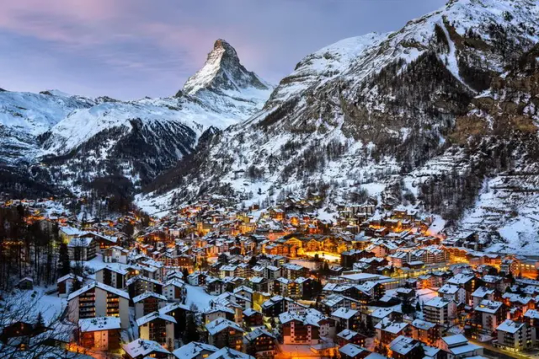
While many people dream about the coming of summer, looking sadly at the snow outside the window, skiers and snowboarders are looking forward to an exciting vacation. On the eve of the winter season, the famous American travel magazine Condé Nast Traveler published the results of the Conde Nast Traveler Readers' Choice Awards. More than 800,000 readers participated in it, who for several months shared their opinions on the offers and services of the tourism market. Based on the survey results, a rating of best ski resorts in the world was compiled that are worth visiting for all lovers of active winter recreation.
Les Arcs La Plagne, France

In the heart of the French Alps, the Haute-Tarentaise Valley, is the famous ski resort of Les Arcs. Together with Peisey-Vallandry and la Plagne it forms the single Paradiski ski area. Les Arcs-la-Plagne includes four mountain stations, named according to their altitude and having a common network of lifts - Arc-Pierre-Blanche (1600 m), Arc-1800, Arc-1950 and Arc-2000. The resort also includes the town of Bourg Saint-Maurice, which lies at the foot of the mountain.
The ski complex offers guests 425 km of slopes of varying difficulty levels, located at altitudes from 1200 to 3225 m. Both beginners and experienced skiers will enjoy skiing here. Novice athletes usually choose the Arc 1800 area, while professionals highly appreciate the Launched Kilometer track on the slope of the Aiguille Rouge mountain. Each level has at least one descent, illuminated at night.
Les Arcs offers many active holiday options for those who do not like skiing. In the Ark-1800 zone there is a snow park with figures, a halfpipe and boarder cross tracks. Several slopes are suitable for freeride. The Launched Kilometer trail offers ziplining. In the Ark-2000 zone, dog sled rides are organized.
Chambery airport is 127 km from Les Arcs, Lyon is 145 km, Geneva is 156 km. You can get there by regular buses and taxis or using a transfer. Bourg Saint-Maurice, which is located 15 km from Les Arcs, has direct trains from Paris, Lille, Amsterdam, Brussels and London.
Chamonix-Mont Blanc, France

At the foot of Mont Blanc in Haute-Savoie is the small town of Chamonix - the center of the oldest French ski resort, Chamonix-Mont Blanc. It also includes the villages of Les Houches, Servoz, Vallorcine and Argentiere.
The excellent infrastructure of Chamonix-Mont-Blanc allows skiing from the end of November to April. On the slopes of the mountain at an altitude of 2000 m there are 100 trails, of which 13 are suitable for beginners, 66 for experienced skiers, and 21 for professionals. A special place is occupied by the famous White Valley - the longest glacier descent in Europe, ranging from 16 to 24 km.
All slopes and pistes are divided into several ski areas - Grands Montets, Flegere-Brevent, Balme-Vallorcine and les Houches-St-Gervais. There is no general network of lifts connecting them all - you need to travel between zones by bus.
The easiest way to get to Chamonix is from Geneva, which is 88 km away. There are buses and transfers from the airport. You can also get there by train, but with transfers - the journey will take about 3 hours.
The fashion for skiing in Chamonix-Mont Blanc appeared at the end of the 19th century. In 1906, a big season was opened here for the first time. And from January 25 to February 5, 1924, the first Winter Olympic Games took place in Chamonix.
Ischgl, Austria
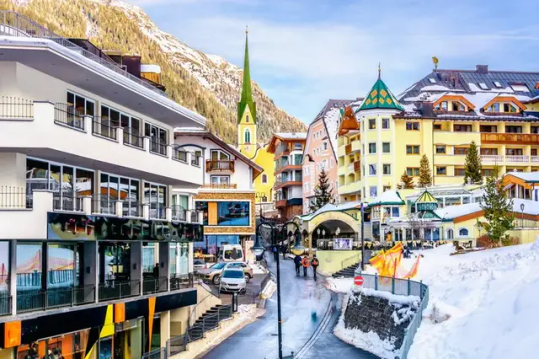
Ischgl is a fashionable and quite expensive ski resort, one of the best in Austria. It attracts with its magnificent nature, beautiful mountain panorama and perfect snow. Ischgl is located in the Silvretta Valley and is connected to its neighbor, the Swiss city of Samnaun, by a network of cable cars and ski lifts. Therefore, with one ski pass you can ski in two countries at once.
The ski area common to both resorts is called Silvretta Arena. This is 239 km of ideal pistes, of which 20 are blue, 40 are red and 25 are black. You can quickly get to any place thanks to 45 modern cable cars.
The ski areas located on the Idalp and Alp Trida plateaus are almost at the level of the glacial horizons - at an altitude of 2400-2800 m. There are no extreme slopes here, wide slopes up to 11 km long alternate with chutes and untouched virgin soil.
Snowboarders will appreciate one of the world's largest snow parks - PlayStation Vita Snowpark Ischgl. It is divided into three zones: for beginners (Beginner Park), intermediate-level athletes (Public) and professionals (Kingsize). Ischgl is one of the best places in the world for snowboarding.
The closest international airport to Ischgl is Innsbruck (99 km). From there you need to take a train or bus to the city of Landeck. There are bus services from the train station to the resort.
Val Thorens, France

The highest resort in Europe, Val Thorens, is the highest point of one of the world's largest ski areas, the Three Valleys. It's great for skiers and snowboarders, but those who don't ski or can't imagine their holiday without nightlife are better off choosing another place. Since the village is located high in the mountains, it will also take time for acclimatization.
Val Thorens is connected to the neighboring resorts of the Three Valleys (Courchevel, Meribel, La Tania, Les Menuires) by a network of lifts and a ski pass. The “ski-to-ski-out” concept has been successfully implemented here - the village is located at the intersection of all ski slopes. The season lasts about 175 days - from mid-November to early May.
The total length of the slopes is 150 km. Of the 88 pistes in Val Thorens, 11 are green, 39 are blue, 30 are red and 8 are black. The snow cover is of very high quality and lasts throughout the entire season. In addition, there are 5 km of cross-country ski trails and a snowpark with a quarterpipe, halfpipe and pyramids.
Three Valleys (Les Trois Vallées), France
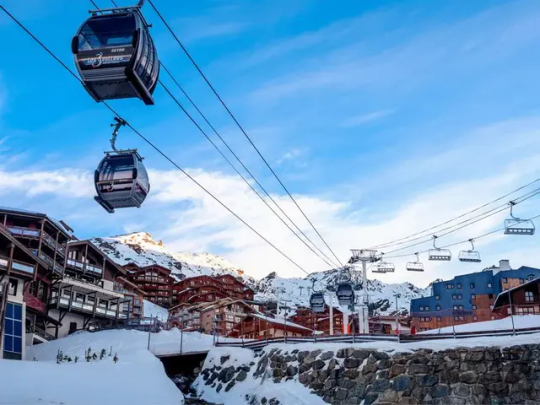
The world's largest ski area, the Three Valleys, unites several French ski resorts located at different altitudes. Among them are the famous Courchevel, Meribel, Val Thorens, Menuires, La Tanya. All of them are connected by a network of lifts. The 3 Vallees ski pass allows you to use all the ski areas of the Three Valleys, but even a whole month is not enough to explore its many slopes.
Les Trois Vallées' 600 km of ski slopes, of which 17 percent are green, 39 percent blue, 33 red and 11 black, attract skiers from all over the world. Athletes with any level of training can ride here - from beginners to professionals. There are 120 km of trails for cross-country skiing enthusiasts. 183 lifts transport 260,000 people per hour. Thanks to the variety of terrain and ski slopes, you can ski in any weather. 8 snow parks and 28 entertainment areas will provide excellent leisure time - no one will be bored.
Altibus shuttles run from the airports of Geneva, Grenoble, Chambery and Lyon to the resorts of Les Trois Vallées. You can check the schedule and book tickets on the carrier’s website www.altibus.com. Trains run from Paris, Brest, Nantes, Lille, Le Havre, Poitiers and other cities to the Moutiers railway station, built for the 1992 Olympic Games. There is a bus service between the station and the resorts.
In order to popularize skiing, Les Trois Vallées often holds promotions. For example, at the beginning of the season (December) and at the end (mid-April) there are reduced prices for ski passes. And on the opening day of the season (in 2021 it is December 4), discounts reach 50%. More details can be found at www.les3vallees.com/en.
Cortina d'Ampezzo, Italy
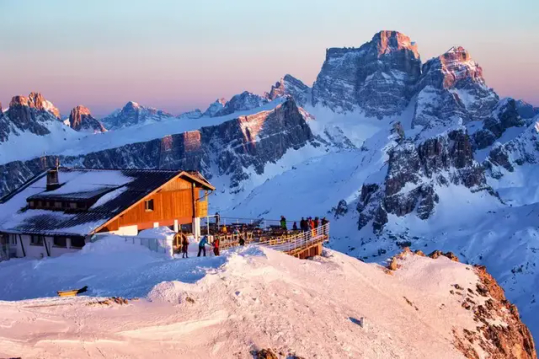
The resort town of Cortina d'Ampezzo was the capital of the Winter Olympics in 1956 and will again be in 2026. World championships in alpine skiing, cross-country skiing and bobsleigh are constantly held here. But wealthy Europeans come here not only for the sake of skiing, but also to, as they say, “show themselves.” The local public demonstrates all the latest sports fashion, and prefers to spend their leisure time in expensive restaurants and boutiques of famous brands located on the main street of the city. Cortina d'Ampezzo is the only ski resort in Italy that is part of the elite ski organization The Best of the Alps.
Even in winter, the sun shines at least 7 hours a day in this region, guaranteeing the best skiing experience. At the disposal of athletes there are 146 km of perfectly prepared slopes, located at altitudes from 1224 to 2828 m. They are served by 36 ski lifts and cable cars.
Cortina d'Ampezzo is part of the Dolomiti Superski ski area, which unites 16 resorts. On the website www.dolomitisuperski.com you can order a ski pass valid throughout its territory.
The closest to Cortina d'Ampezzo is Venice Airport (162 km), from where you can get there in 3-3.5 hours by ATVO bus or book a transfer. There are no direct trains. With transfers you can travel from Venice to the cities of Dobbiaco and Calalzo di Cadore, from where SAD and Dolomiti Buses run to Cortina.
Cervinia, Italy
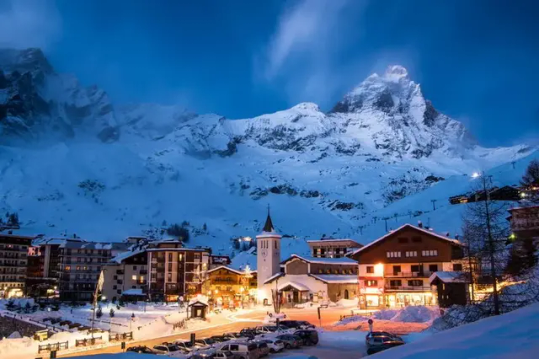
The highest ski resort in Italy, Cervinia attracts winter holiday enthusiasts with beautiful scenery, guaranteed snow and a long season. The large ski area is equipped with a well-thought-out system of various types of lifts. Ski passes allow you to ski not only on the southern slopes, which belong to Italy, but also on the northern ones, which are the area of the Swiss resort of Zermatt.
The town of Breuil-Cervinia is located at an altitude of 2050 m and is surrounded by the majestic peaks of Monte Rosa (4637 m), Matterhorn (4478 m), Breithorn (4165 m) and Castore (4228 m). The highest point is at an altitude of 3488 m. Here you can take a cable car above the clouds and then ski through them.
Cervinia is divided into four ski areas: Plan Maison, Laghi Cime Bianche, Plateau Rosa and Valtournenche Valley Slope. In total, in the Breuil-Cervinia-Valtournenche-Zermatt area there are 69 slopes, the total length of which is about 360 km. In addition, there is a snow park called Indian Park.
The airports closest to Cervinia are Milan and Turin. The journey from Milan by bus takes 3.5 hours. You can take the train to Chatillon, after which you can take a bus. From Turin you also need to take a bus with a transfer in Chatillon.
Zermatt, Switzerland
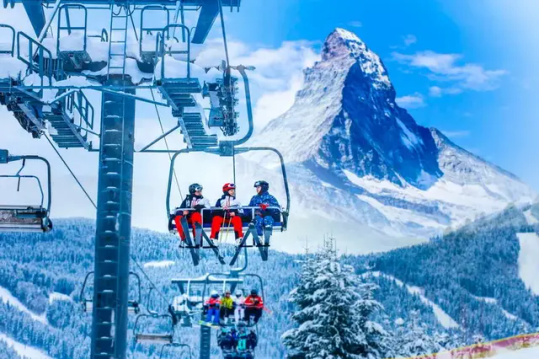
The unique ski resort of Zermatt in Switzerland offers skiing and snowboarding all year round. There is constant snow on the Theodul glacier - the snow park here operates both in winter and summer. In 2020, Zermatt was voted the best resort in the Alps for the third time.
Zermatt-Matterhorn and the neighboring Italian resort of Breuil-Cervinia share a ski area with 54 lifts. Of the 360 km of trails, 74 km are blue, 227 km are red and 20 km are black. There are also 36 km of yellow freeride slopes. Children under 9 years old can use the lifts free of charge.
Those who don't like skiing should come to Zermatt if only to admire the Matterhorn, the most photographed peak in Europe. But there is plenty of other entertainment here. You can go sledding or go on a snowshoe tour, and relax in the spa in the evening. The city is famous for its cafes and restaurants, two of which, After Seven and Le Capri, have been awarded a Michelin star.
In 2018, the world's highest cable car, the Matterhorn Glacier Ride, opened at the resort of Zermatt, connecting the peaks of Trockener Steg (2939 m) and Klein Matterhorn (3883 m). The lift is equipped with 25 gondolas, including four luxury cabins. They are decorated with 280,000 Swarovski crystals laid out in the shape of mountain peaks, and the lighting on the ceiling imitates the starry sky.
Verbier, Switzerland
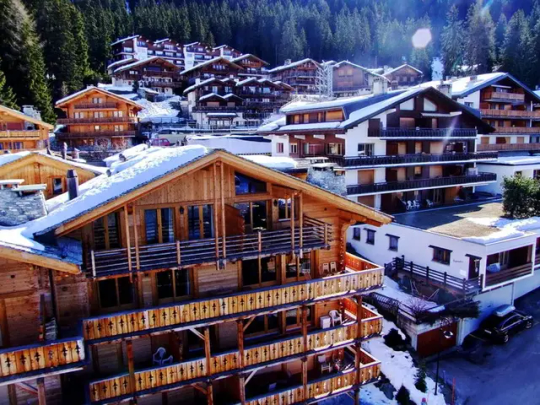
Verbier is part of the largest Swiss ski area, the 4 Vallees (Four Valleys), which also includes the ski resorts of Nendaz, Veysonnaz, La Tzouma and Thion. The city is located in the Bagnes valley, offering a magnificent panorama of the Alpine massifs and the Mont Blanc mountain.
The season in Verbier lasts from late November to April. The resort is preferred mainly by experienced skiers and freeride enthusiasts. The total length of its routes is about 200 km. There are slopes for beginners here, but they are few. For those who lack adrenaline, there are the famous black slopes in the Snowy Riviera - Mont Fort, Mont Gelle and Tortin.
There are two types of ski passes in Verbier: for skiing only in the Verbier area or for the entire Four Valleys region, which includes about 400 km of slopes connected by lifts. At an altitude of 2260 m there is a snowpark 1936 Neipark.
The closest airport to Verbier is in Geneva - from here there are daily shuttles to the resort. You can take a train from Geneva to Martigny, where you will have to change to a bus or taxi.
Courchevel, France
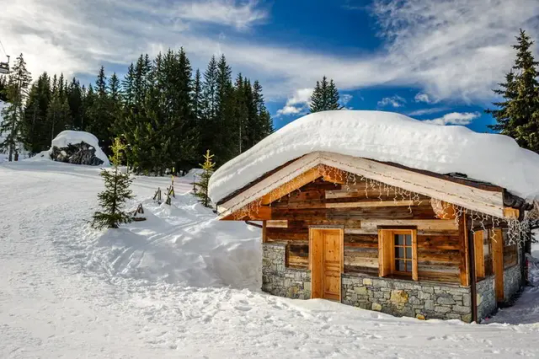
Courchevel is one of the oldest ski resorts in France, which has long become a symbol of luxury winter holidays. But luxury hotels, branded boutiques and Michelin-starred restaurants are only a worthy setting for its main assets: luxurious landscapes and excellent pistes. Here you can find all the best that ski lovers could wish for.
Courchevel is part of the joint ski area Les Trois Vallées. The resort includes six villages located at different altitudes: Saint-Bon, Le Praz, La Tania, Village, Moriond, Courchevel 1850 ( Courchevel 1850). Skiers are offered 150 km of excellent trails of varying difficulty levels, including special Easy Rider areas for beginners and theme parks for children. By purchasing an unlimited ski pass, you can ski on the slopes of the entire Three Valleys zone, which is more than 600 km.
In addition, the Courchevel Valley has illuminated slopes for night skiing, 65 cross-country ski routes and a snowpark. Fans of freeride will be able to enjoy untouched virgin soil.
Courchevel has its own small airfield and helipad. Air transfer from Lyon and Geneva airports takes just minutes. But this is an option for wealthy guests. It is much cheaper to travel by Altibus buses. You can take the train to Moutiers Salins station, from where buses go to the resort.
Megève, France

Megève was recently awarded membership in the Best of the Alps ski club. Representatives of French bohemia regularly vacation here and one of the branches of the Rothschild dynasty permanently resides here. The ancient Alpine town is famous for its high level of service, Michelin-starred restaurants and luxury boutiques.
The resort combines two ski areas: Evasion Mont-Blanc and Les Portes du Mont-Blanc. More than 200 ski slopes in Megève with a total length of about 400 km are created for relaxing and comfortable skiing. The gentle slopes here are ideal for beginners. But there are also interesting places for thrill-seekers, for example, the steep descent of Emile Allais in the Alpet Valley. Those who want to go off the beaten path will be able to get an unforgettable experience of skiing on virgin soil and the glacial descent of Vallée Blanche. In the Evasion Mont-Blanc area there are 7 parks for snowboarders and freestylers, as well as several toboggan areas.
The easiest way to get to Megève is from Geneva airport (86 km). Transfer by bus or helicopter is provided. There is a direct train to Sallanches Station, 12 km away. From the station you can get to the city by bus or taxi.
Val d'Isere, France
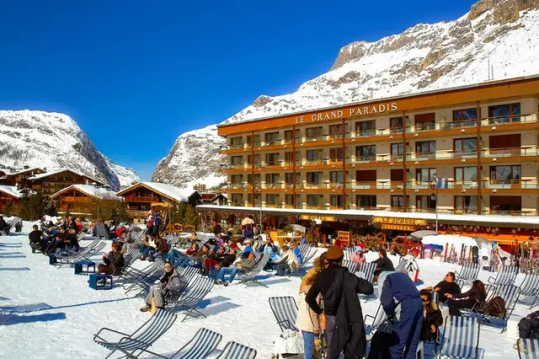
Val d'Isere and the neighboring resort of Tignes are part of the combined ski area Espace Killy, named after the French Olympic champion Jean Claude Killy. There are more than 300 km of ski slopes, served by 90 ski lifts and funiculars. 20 green, 67 blue, 41 red and 26 black slopes make Val d'Isere attractive to skiers of all skill levels.
It includes three ski areas: Le Solaise, Bellevarde and Le Fornet. Their altitude and climatic features of the region provide excellent snow cover, allowing the season to extend until the end of May. You can ski on the slopes of the Grande Motte glacier in Tignes even in summer. Freeride lovers will find 10,000 hectares of virgin snow at an altitude of 1550-3500 m. Val d'Isere also offers other winter recreation options - trekking, cross-country skiing, and dog sledding. Snowboard lovers should pay attention to Valpark - there is a halfpipe, big air, jumps and all kinds of jibbing figures.
Read the full article
0 notes
Text
SAINT OF THE DAY (February 12)

St. Julian the Hospitaller, or "the Poor Man," came from a wealthy, noble family in the early 4th century. He is a popular saint in Western Europe.
According to legend, while Julian was a baby, he was cursed to one-day kill his own parents.
His father wanted him killed, but his mother kept him alive. When he was old enough to learn of the curse, he left his family to preserve their safety.
While he was hunting, his mother and father made an unexpected visit to his castle.
His wife gave them one of the best rooms. He received a vision from the devil that his wife was in his bed with another man, and he returned home to kill whoever was in his bed.
When Julian returned from his hunt and saw the two figures in bed, he assumed it was his wife with a lover. In a jealous rage, Julian killed his mother and father.
Julian was so horrified upon learning the truth that he swore to devote the remainder of his life to good works.
He and his wife then undertook a pilgrimage to a distant country where he established a hospital.
The hospital was near a river that was frequently crossed by people prompted to travel by the Holy Crusades.
People frequently drowned crossing this river, so Julian took responsibility of ferrying travelers across and tending to the sick.
One night, the devil vandalized his house and blaming it on those he helped, Julian said that he would never house anyone else ever again.
God showed up at his door, asking for help, and he denied Him.
Julian answered with contempt:
'I shall not let you in. Go away, for the other night, I had my home so vandalized that I shall never let you in.'
And Christ told him:
'Hold my walking-stick, please.'
Julian, embarrassed, went to take the stick, and it stuck to his hands. And Julian recognized him at once and said:
'He tricked me, the enemy who does not want me to be your faithful servant.'
He knelt and Jesus forgave him. Julian asked, full of repentance, forgiveness for his wife and parents.
He retracted his statement and decided to help all those who needed it once again.
One night, thieves came into their hospital, then killed Julian and his wife in the same way Julian had killed his mother and father.
“There were great miracles without end in that place and land,” recounts the legend. “So many that, as it pleased God, their bodies were brought to Brioude (France).”
St. Julian is considered the patron of ferrymen, innkeepers, and circus performers.
10 notes
·
View notes
Text
Tourism and Travels

Garda Lake Italy Tourism and travel
Tourism and travels. Take a tour around the world: culture, traditions, curiosities, towns, lakes, mountains, photos, links, and videos by English-culture.com
Global Tourism Resilience Day (17 February), proclaimed by the General Assembly in resolution A/RES/77/269, aims to emphasize the need to foster resilient tourism development to deal with shocks, taking into account the vulnerability of the tourism sector to emergencies. For instance, Tourism and Green Investment, encourages a focus on improved travel experiences and innovative solutions “for people, for planet and for prosperity”.
We recommend Garda Lake for your travel experiences. It is an ideal touristic place, together with some stunning places in Great Britain, such as the Lake District, the Scottish Highlands, London or other famous towns in England, Germany, America, France and Italy.
Garda Lake (Lago di Garda or Benaco) is the largest Italian lake, situated at the foot of the Alps, in a beautiful area of southern Europe. At only 30 Km from Verona, 100 Km from Milan and 130 Km from Venice it is well placed for road, rail and air connections. It is located in Northern Italy, about half-way between Venice and Milan. Glaciers formed this alpine region at the end of the last ice age.
The northern part of the lake is narrower, surrounded by mountains, the majority of which belong to the Gruppo del Baldo. The shape is typical of a moraine valley, probably having been formed under the action of a Paleolithic glacier. Although traces of the glacier's actions are evident today, in more recent years it has been hypothesized that the glacier occupied a previously existing depression, created by stream erosion 5 to 6 million years ago. The lake has numerous small islands and five main ones, the largest being Isola del Garda. Nearby to the south is Isola San Biagio, also known as the Isola dei Conigli ("Island of the Rabbits").
Both are off shore of San Felice del Benaco, on the west side. The three other main islands are Isola dell'Olivo, Isola di Sogno, and Isola di Trimelone, all further north near the east side. The main tributary is the Sarca River, while the only emissary is the Mincio River.The lake and its shoreline are divided between the provinces of Verona (to the southeast), Brescia (southwest), and Trento (north). Being easily accessible from the north via the Brenner pass, the lake is a major tourist destination, including a number of exclusive hotels and resorts along its shore.
Lake Garda offers the visitor a splendid natural scenery, full of colours, surrounded by the Dolomites of Brenta in the north and the gentle slopes of the morainic hills in the south. A rich vegetation flourishes thanks to the Mediterranean climate: lemon trees, oleanders, magnolias and bouganville. The cultivation of vineyards and olive groves produces good wines and olive oil. Walking leisurely around the small village centres, going on a boat trip, exploring the surroundings in a wide choice of itineraries are the best ways of enjoying the lively atmosphere of the lake and the beauty of the landscape. Moreover, Lake Garda is ideally situated for excursions: to the historical cities of Verona, Brescia, Mantua, Trent and Venice, to the Dolomites, to a performance at the Arena in Verona during the Opera Season.
In this region almost every sport can be practised from tennis to paragliding, free-climbing, scuba-diving, clay-pigeon shooting and karting. Sailing and windsurfing enthusiasts find here their ideal conditions and over the last years Lake Garda has been chosen by lovers of mountain-bike and has become world famous for the quality of its golf courses. If looking for fun and relax there is a good choice of amusement parks and gardens; for those who love shopping there are opportunities meeting all needs, from the picturesque street markets to the most elegant shops.
Lake Garda is also well known for its exciting night-life, its dolce vita: restaurants, cafes, the trendiest discos and entertainment of all kinds are to be found everywhere. For those who are thinking of a holiday in this attractive part of Italy Garda Vacanze is glad to present the best hotels, holiday apartments, farm holidays and campings round Lake Garda, chosen for the high standard of service, the pleasant location and the outstanding value for money. As Lake Garda is one of the most exclusive venues for business meetings and incentives in Italy, Garda Vacanze suggests suitable 4 and 3 star hotels, perfectly equipped with conference facilities.
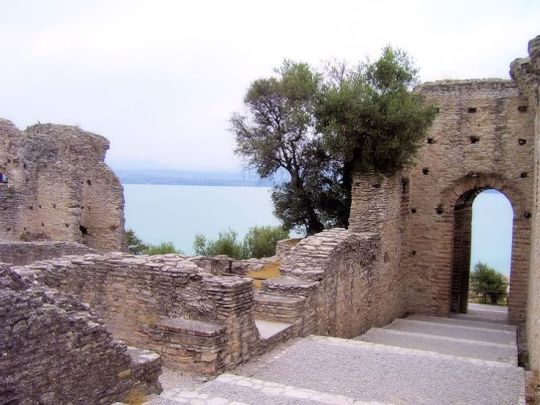
Garda Lake Sirmione Italy
Lake Garda is the most important European lake, and it has always been a renowned tourist area.
The land is characterised by two colours that give a feeling of joy and peace: blue as the waters illuminated by the sun, and green as the gentle hills surrounding the lake. Thanks to the lake's mediterranean climate, plants and flowers flourish everywhere: vines, bougainvillae, lemon groves, olive trees.
Apart from its clear waters, the lake has plenty to offer: art (the Vittoriale museum, the Art Nouveau villas), entertainment (water parks, concerts, shows, live clubs), nature (the lemon gardens, natural parks), sports (sailing, windsurf, water ski, canyoning, rafting, paragliding, trekking, mountaineering, climbing), shopping in the elegant boutiques of the lake promenades.
Three beautiful golf courses are available on the western coast, and are renowned all over Europe. Spas and top-quality wellness centres are also very well known.
Lake Garda is worth a visit also for its typical products such as wine (high-quality red and white wines such as Groppello, Lugana and Garda Classico), extra-virgin olive oil, and delicious traditional dishes based on lake fish and spits.
Worldwide famous painters, writers and artists like Goethe, D’Annunzio, Ibsen and Lawrence lived here and from the harmony of the lake drew inspiration for some of their important works.
On the Garda Lake we have more than 1,200 hotels, 1,024 restaurants, 410 pizza-restaurants, 480 bars, 22 discotheques, 206 campings and 60 holiday farms.
www.officeholidays.com
Job tourism in Lombardy
Turismo enogastronomico
The Lake District
The Scottish Highlands
City guide around London
Dickens literary London
The London Marathon
Christmas Markets in England
Christmas markets in America
Christmas markets in Italy and Germany
http://www.youtube.com/watch?v=ojzyMJN32Is
Rss Feed about Travel and Tourism
Rss Feed about Hotels and Resorts
Read the full article
1 note
·
View note